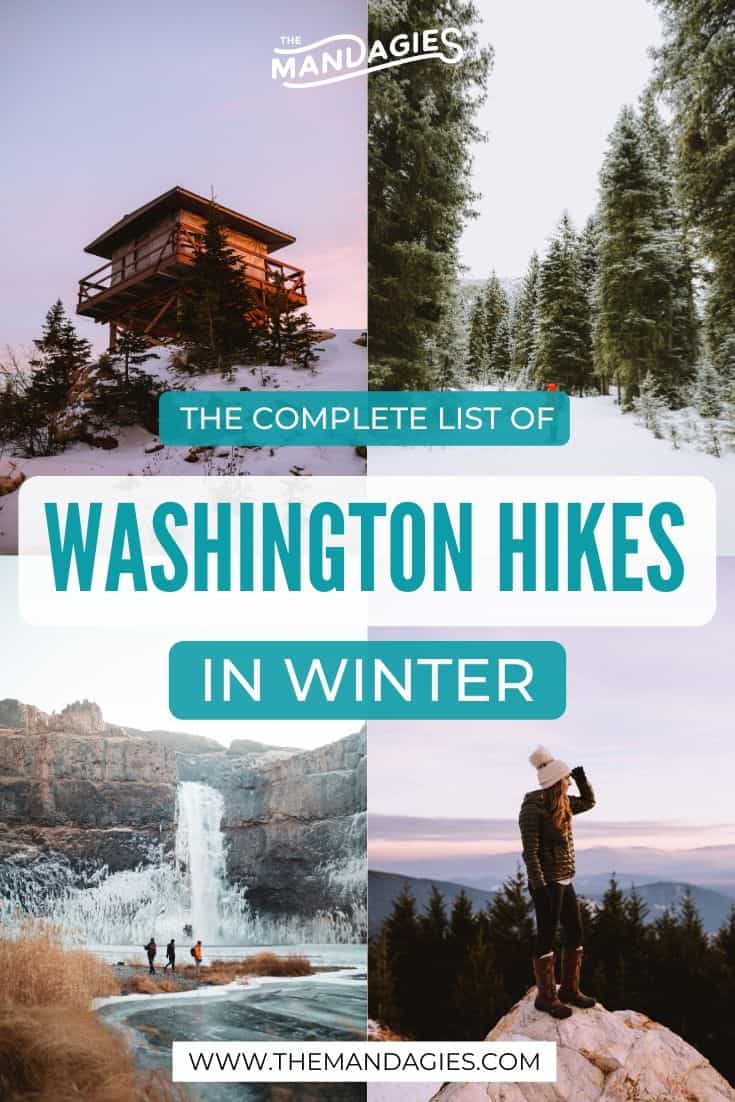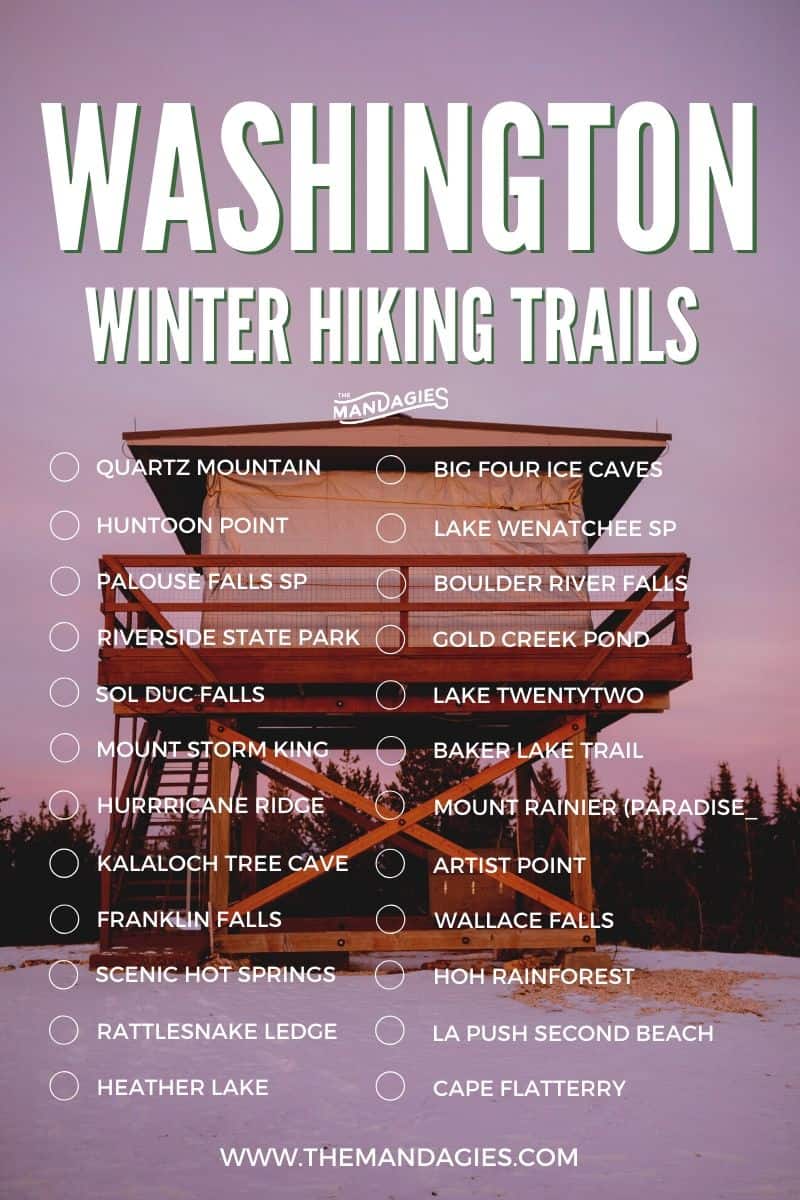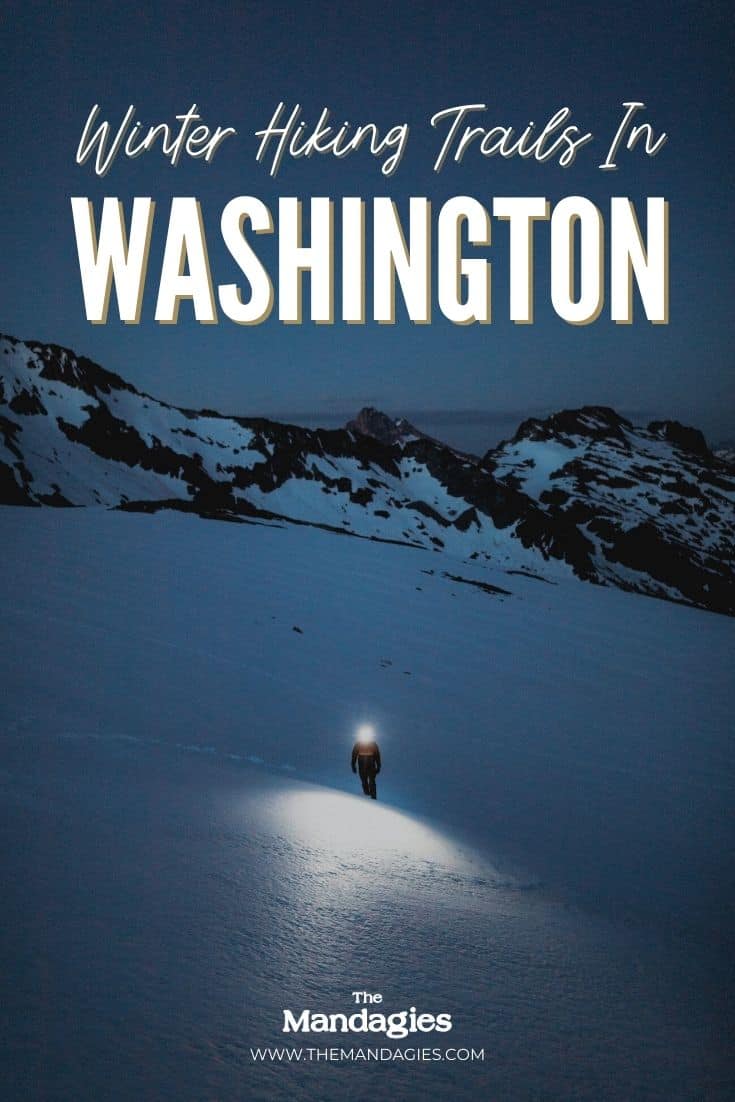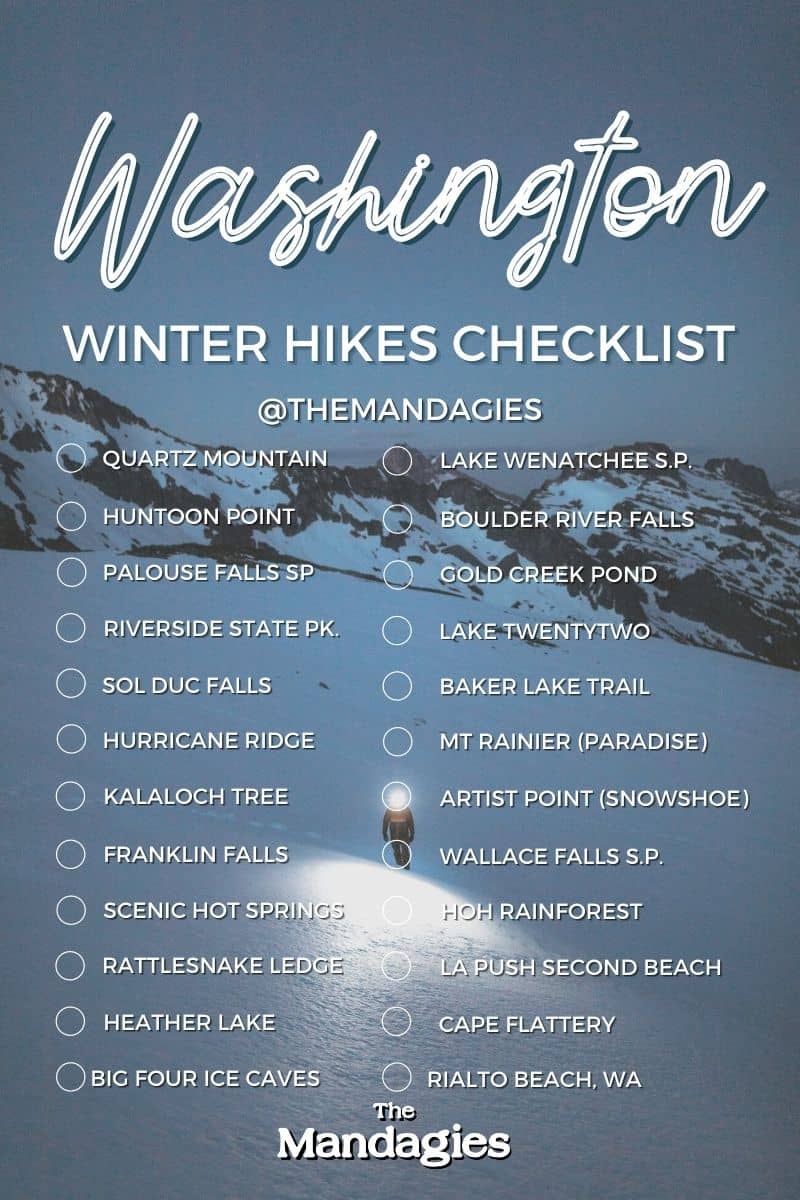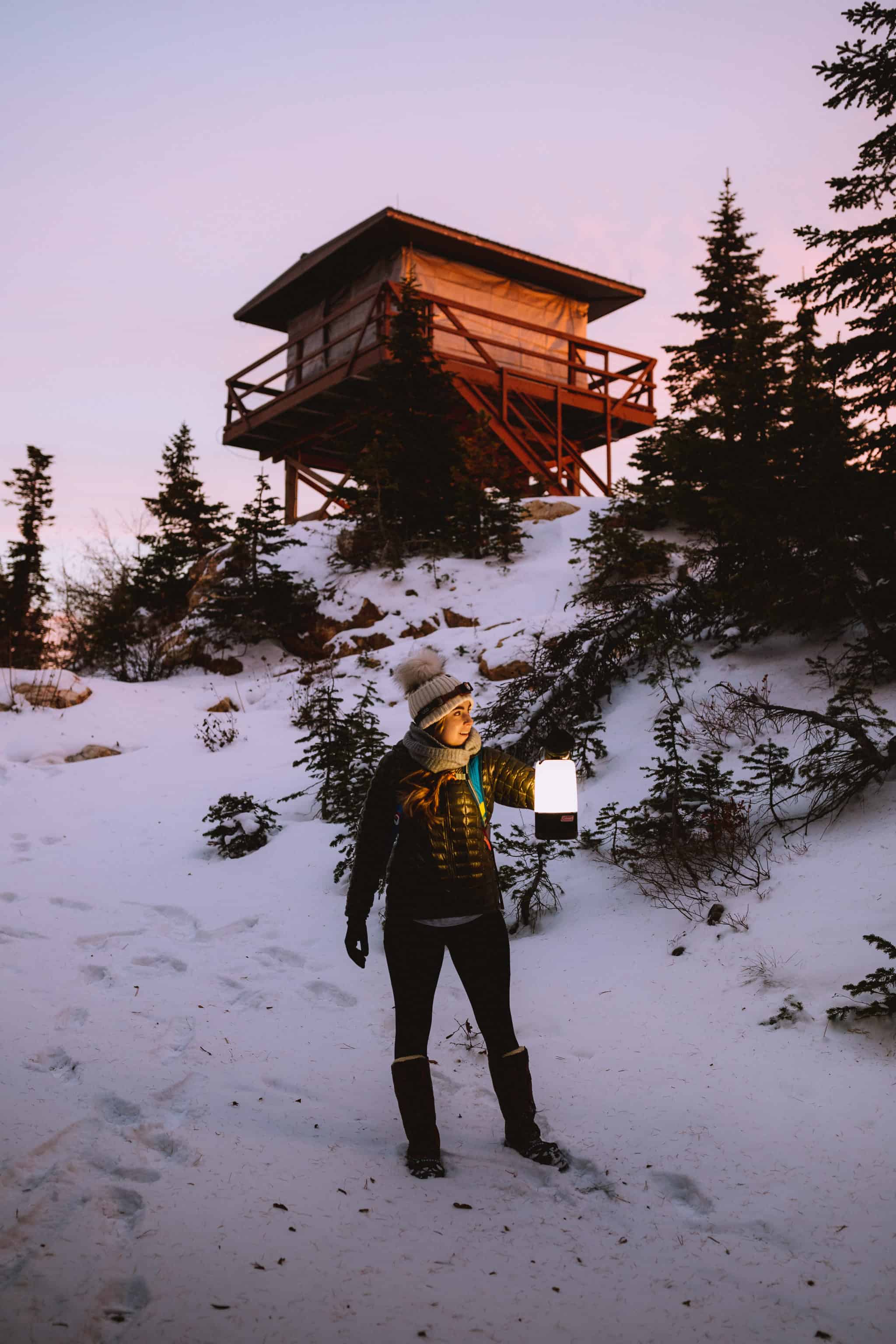Post Summary: Best Winter Hikes In Washington State And Where To Find Them
Think that your favorite Pacific Northwest hiking trails are closed for the season? Think again! Some of the best things to do in Washington can actually be discovered when it’s cold outside!
With a wide mix of climates (desert, rainforest, mountains, etc) Winter in Washington provides so many ways to get outside in the cold season. Lots of hikes in Washington are still open for the winter!
With a bit of a seasonal twist, these winter hiking trails in Washington will get you outside breathing that fresh mountain air in no time. From frozen Washington waterfalls, snow-capped mountains, and foggy forests, we’re sharing our favorites with you right here!
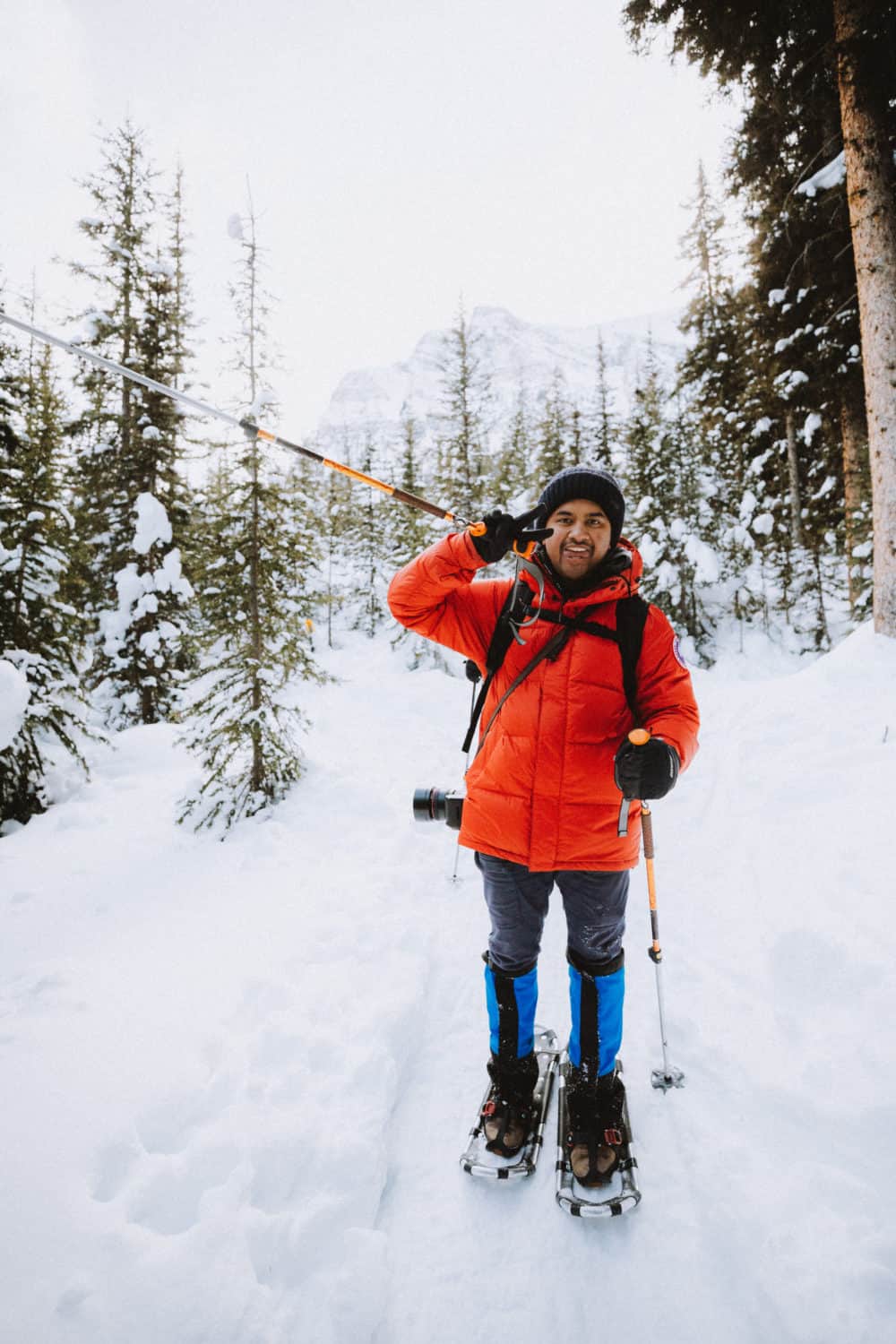
In this post, we’re spilling all the details of our favorite Washington winter hikes from all around the state.
From Eastern Washington all the way to the Olympic Peninsula, we’re here to get you outside and experience your best winter yet.
Let’s get started!
Note: This post on Washington winter hikes contains affiliate links, vetted and chosen by yours truly!
Safety Tips On Washington Winter Hikes
Just like any outdoor activity, winter hiking comes with a lot of inherent risks.
From avalanche danger to hypothermia, there are a lot of things to know and consider before just setting off on a trail. Read our safety tips below to help you prepare for your Washington winter hikes this season.
Avalanche Safety Is Essential To Know For Hiking In Washington In Winter
Backcountry winter hiking trails in Washington require avalanche knowledge to best prepare you for the risks involved. Avalache.org provides free avalanche education videos and resources on where to attend avalanche training classes.
If you are planning to venture out on slopes more than 35 degrees in angle, know before you go. Not comfortable or not prepared? Simply avoid the area and take another trail!
Download Topography Maps In Preparation For Your Winter Hiking Trail
What if you’re the first one on the trail after a fresh new layer of snow? How do you know where the trail is? One of the best ways to navigate trails in the snow is by downloading these hiking apps on your phone!
There are many phone topo apps to choose from, but we personally love AllTrails for their “save” feature, Gaia for their downloadable maps offline, and Avenza Maps that use GPS rather than cell service!
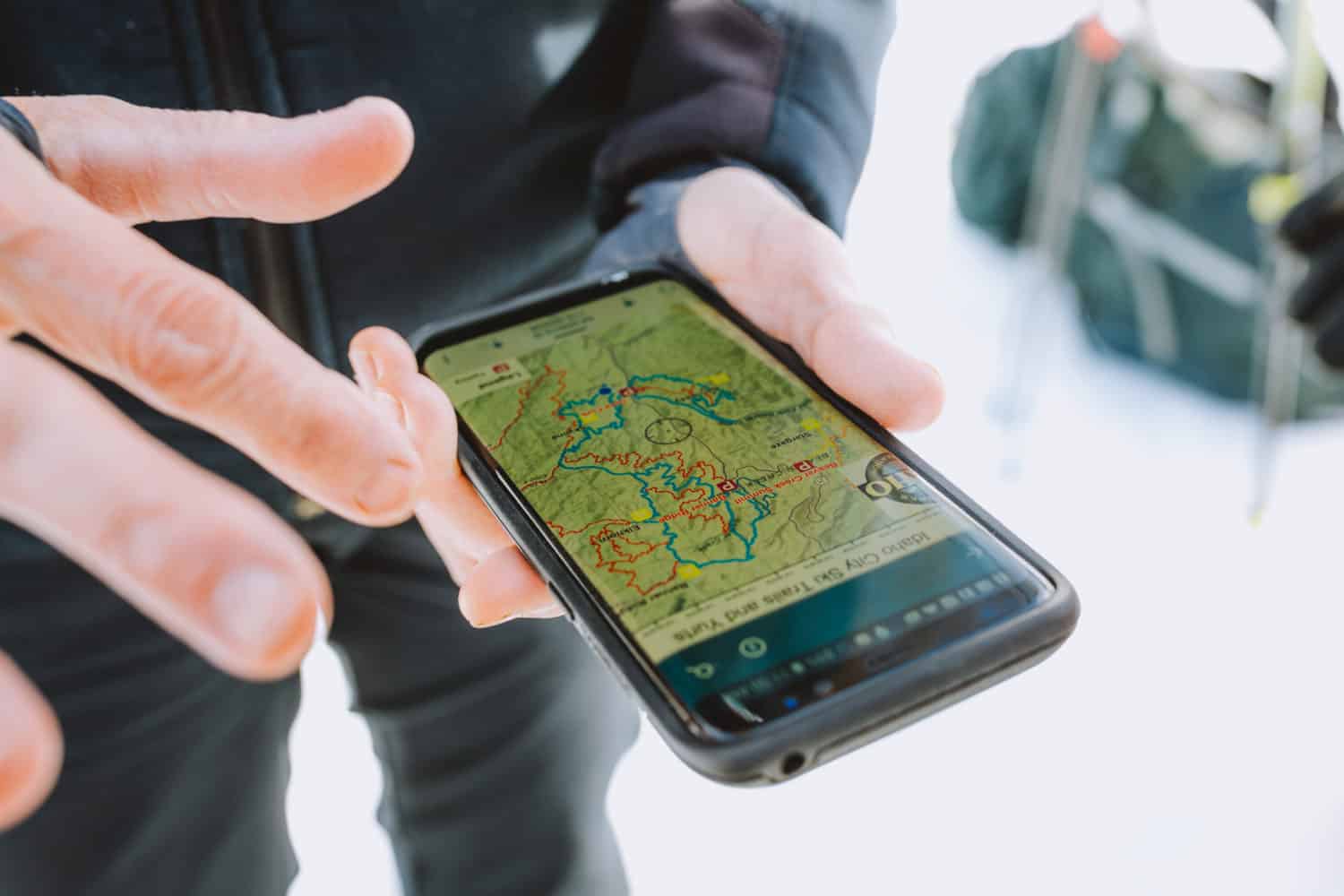
Pack The 10 Hiking Essentials For Washington Winter Hikes
Similar to the 10 PNW hiking essentials for the summer, the most important one here is warm, insulating layers! Here are other essentials to consider for your Washington winter hikes:
- Map + Compass (see above for favorite topography apps!)
- Sun Protection
- Warm Clothing
- Headlamp or Flashlight
- Emergency Shelters like a tarp or reflective blanket
- First Aid Kit
- Hydration Supplies
- Fire Starting Supplies
- Repair Tools
- Food/Nutrition
Read Trip Reports And Reviews Before You Go
One of the most important preparations you can take for your Washington winter hikes is to read trip reports before you venture out. You can find these reports on AllTrails and the Washington Trail Association websites.
Scroll down to the bottom of the web page and read hiker trip reports that have gone on in the past few days. They will tell you what to look out for (icy conditions, potholes on the road, avalanche warnings, etc), so you get a good idea of the conditions of your Washington winter hike before you go.
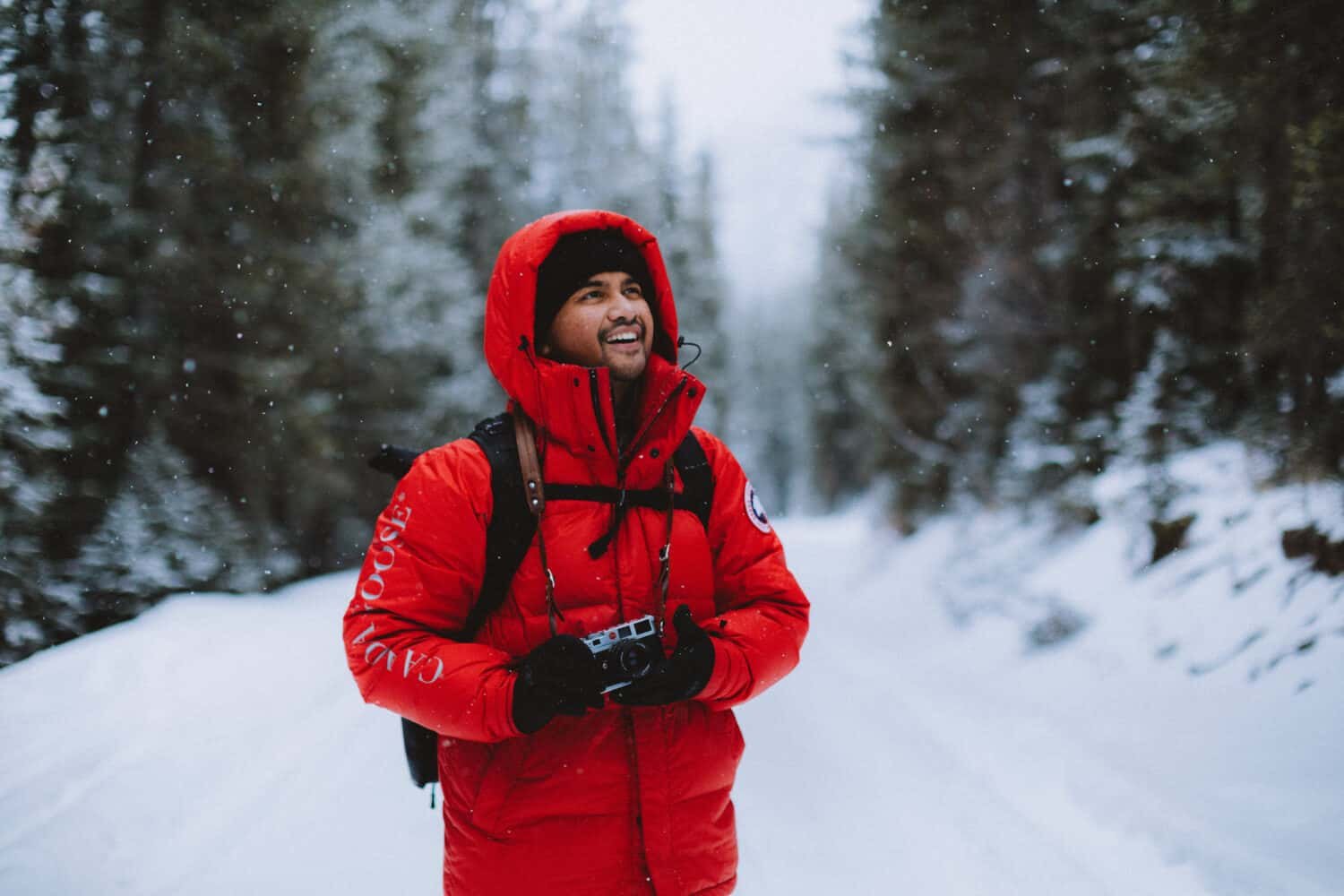
Best Winter Hikes In EASTERN WASHINGTON
Eastern Washington is a unique place to go hiking in the wintertime. The snow sticks around longer, the air is crisp and biting, and there are plenty of opportunities to get trails all to yourself!
By the way, if you want to stay longer, check out our Eastern Washington road trip route. It takes you to some of the coolest spots (and hiking trails) east of the Cascades!
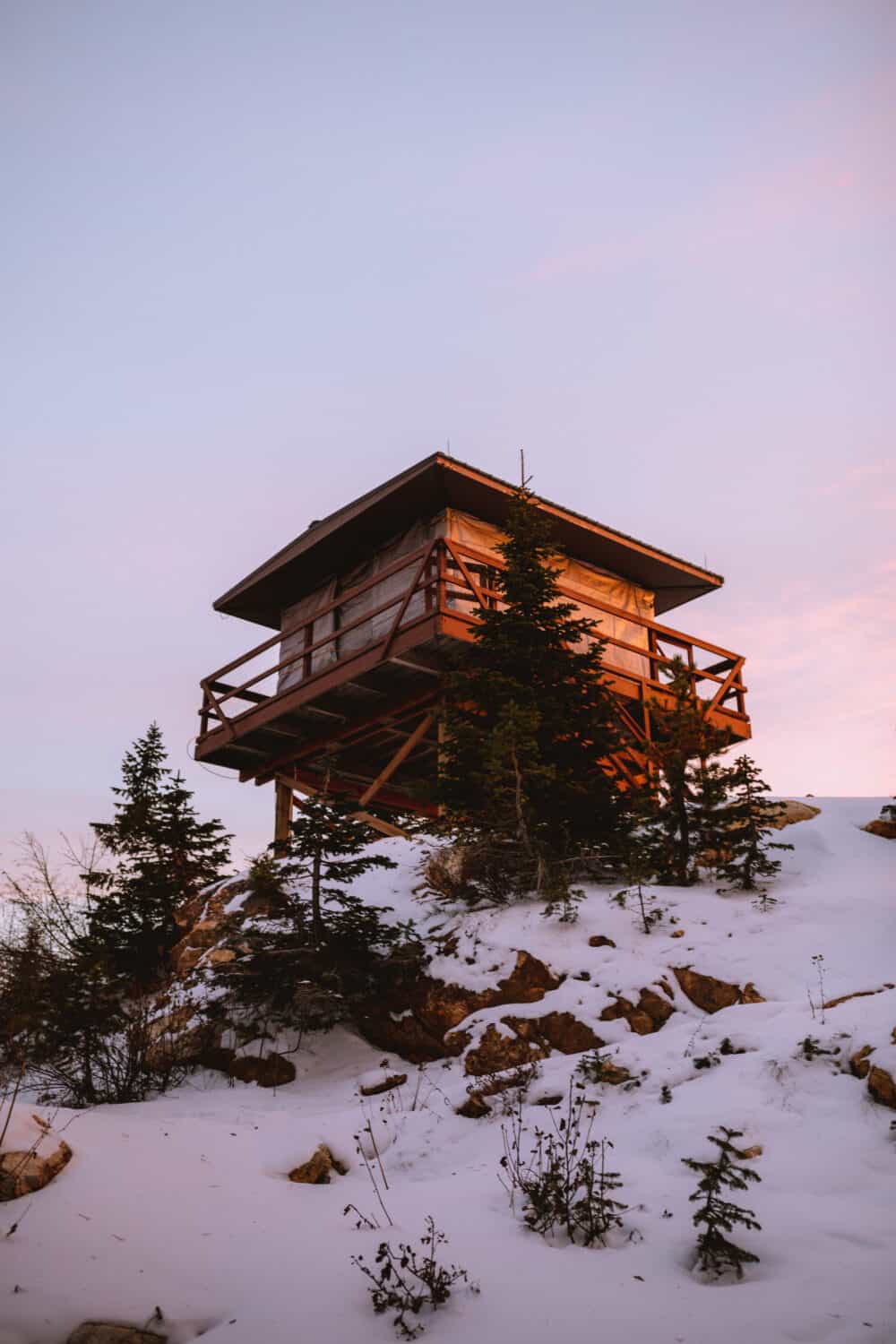
Quartz Mountain Lookout
- Trail Length: 4.5 miles out-and-back
- Elevation Gain: 685 feet
- Difficulty: Moderate
- Washington Winter Hiking Features: Fire Lookout, Sunset Views of Newman Lake and Spokane Valley
- Trailhead Location: Mt Spokane State Park Nordic Ski Area – Selkirk Lodge
Quartz Mountain Lookout is located in Mount Spokane National Park, on the east side of Washington state.
This is one of the more popular winter hiking trails in Washington for its customizable trail routes, and of course, the views atop Quartz Mountain.
These are groomed and maintained trails, which means you’ll have to obtain a Sno Park Pass AND a Special Groomed Trails Permit. Seasonal permits pay for themselves in just two visits to Washington winter trails, so they are worth the investment if you plan to spend a lot of time outside!
Start your journey at the green and yellow Selkirk Lodge, and choose your own groomed trail adventure from their easy-to-read maps at every junction. Snowshoers and Nordic Skiers are welcome!
Read More: What To Expect On Your Hike To Quartz Mountain Lookout
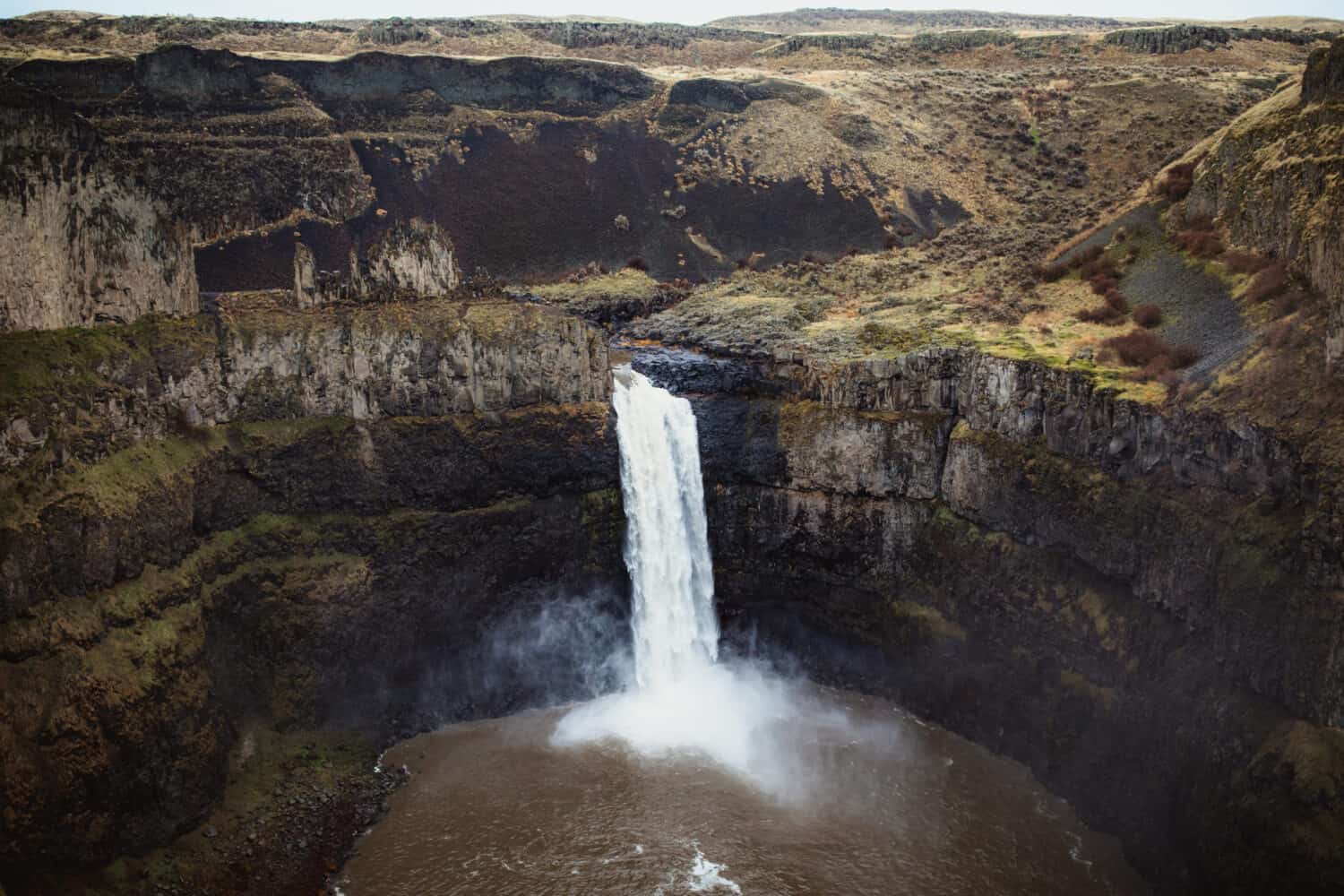
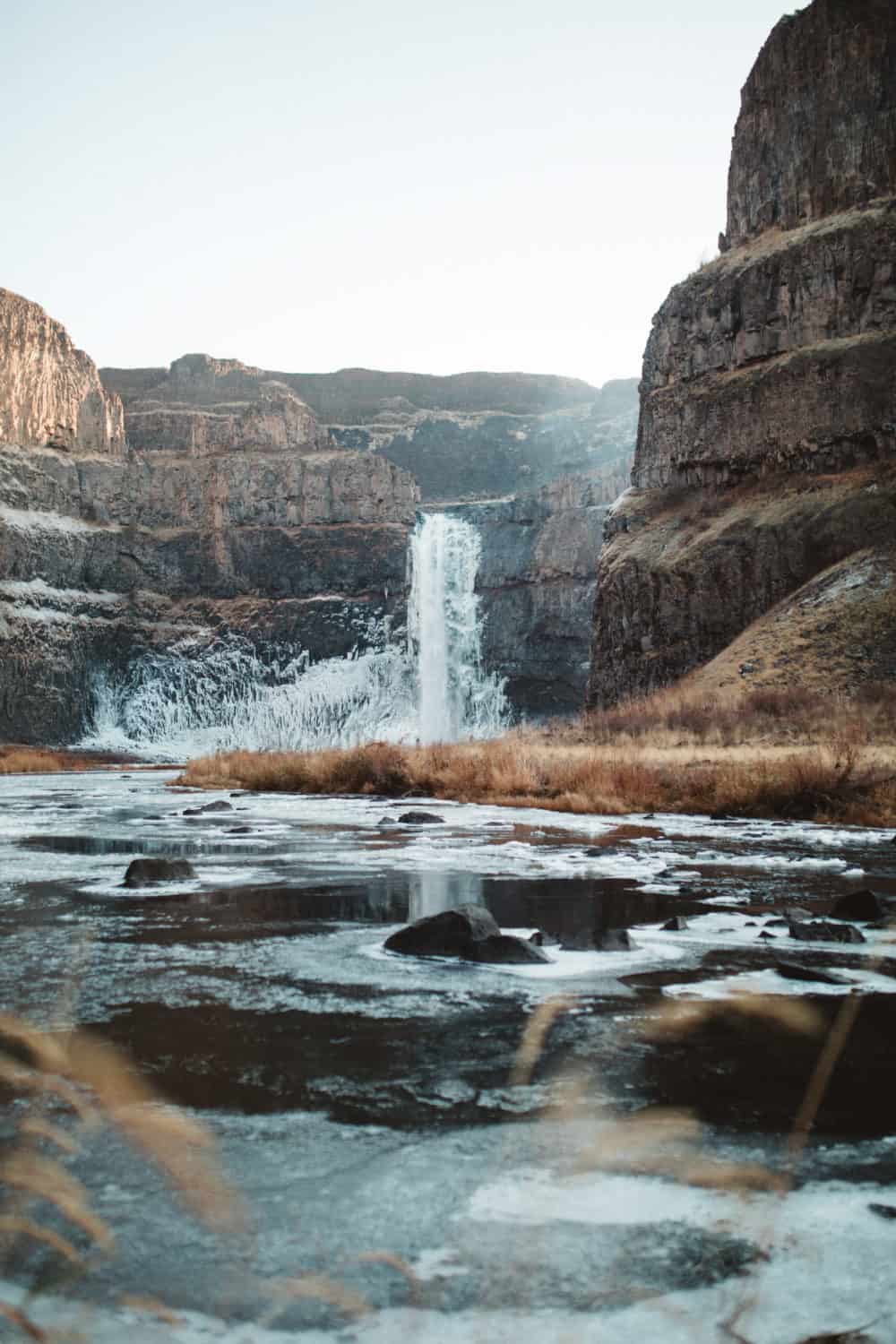
Palouse Falls State Park
- Trail Length: 1.2-mile loop
- Elevation Gain: 50-200 feet
- Difficulty: Moderate
- Washington Winter Hiking Features: Washington State’s Waterfall
- Trailhead Location: Palouse Falls State Park, Eastern Washington
Coming to Palouse Falls State Park in the winter will bring you to another gorgeous frozen waterfall! There really isn’t a set trail to take, but rather a gravel path that borders the rim of the canyon for many different angles and perspectives of the falls below.
This short trail is best taken during sunset! Come to watch the sunset on the canyon rim and experience this magical golden hour for yourself.
Hikers Note: You may see images with views from the base, which are technically legal. However, these social trails are NOT encouraged by the State Park for use. Please note that there is no cell service and park rescue is at your own cost (helicopters cost a LOT, you know) so really, really think about the risks you’re taking before your trip to the bottom.
Loose rock, steep climbs, and a hazardous descent have taken lives in the canyon as late as 2015. Know your risks and read our terms and conditions to let you know you’ve been warned.

Riverside State Park (Bowl And Pitcher Loop)
- Trail Length: 2-mile loop
- Elevation Gain: 125 feet
- Difficulty: Easy
- Washington Winter Hiking Features: Views of the Spokane River, Rock Formations
- Trailhead Location: Riverside State Park, Spokane, Washington
The Bowl and Pitcher Loop Trail in Riverside State Park is loved by Eastern Washington residents and visitors alike! This easy and beautiful trail begins across a beautiful suspension bridge built by the Civilian Conservation Corps (CCC) and winds its way into the forest and finally alongside the Spokane River.
With over 55 miles of easy trails to explore in Riverside State Park, this area is perfect for Washington winter hikes all season long! Make sure to bring your Washington Discover Pass ($30 purchased annually) to get access to the entire park!
Read More: Stunning Locations To Discover In The Inland Northwest
Best Winter Hikes In OLYMPIC NATIONAL PARK
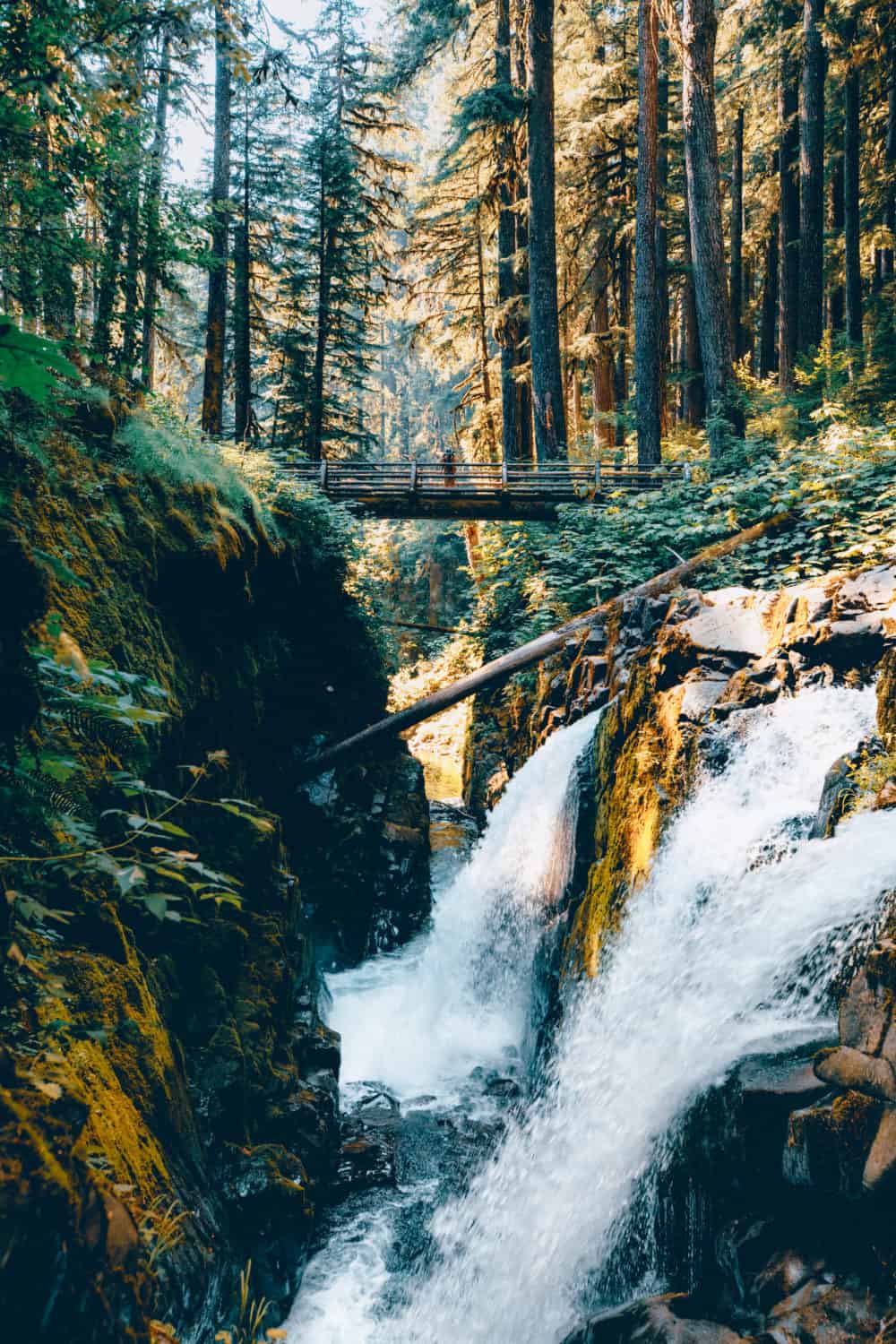
Sol Duc Falls
- Trail Length: 1.6 miles out-and-back
- Elevation Gain: 200 feet
- Difficulty: Easy
- Washington Hiking Features: Waterfalls, Rainforest, Hot Springs (Nearby Resort)
- Trailhead Location: Olympic National Park, North Side
Sol Duc Falls is one of the easier Washington winter hikes located in the Olympic National Park near Port Angeles, Washington. Located in a temperate rainforest, this place’s accessibility extends long after many other trails are closed, but it does eventually get snowed in after a big storm. (then you’ll have to wait until spring to hike it again!)
For first-time hikers in Washington, this is an excellent trail choice for its short distance and huge end reward! However, after some trail experience, make sure to come back in the summer to hike the longer 19-mile High Divide / Seven Lakes Basin Loop from the same trailhead!
The family-friendly trail winds you through the forest, across Sol Duc River, and ultimately to a stunning slot canyon that divides the falls into three different sections. Bring your tripod and try catching the water flow with a long exposure for an incredible Pacific Northwest photography opportunity!
Want to stay longer on the Olympic Peninsula? Consider staying overnight at the Sol Duc Hot Springs, a forest resort located on Sol Duc Road, the same one as the falls! (But check their opening times!)

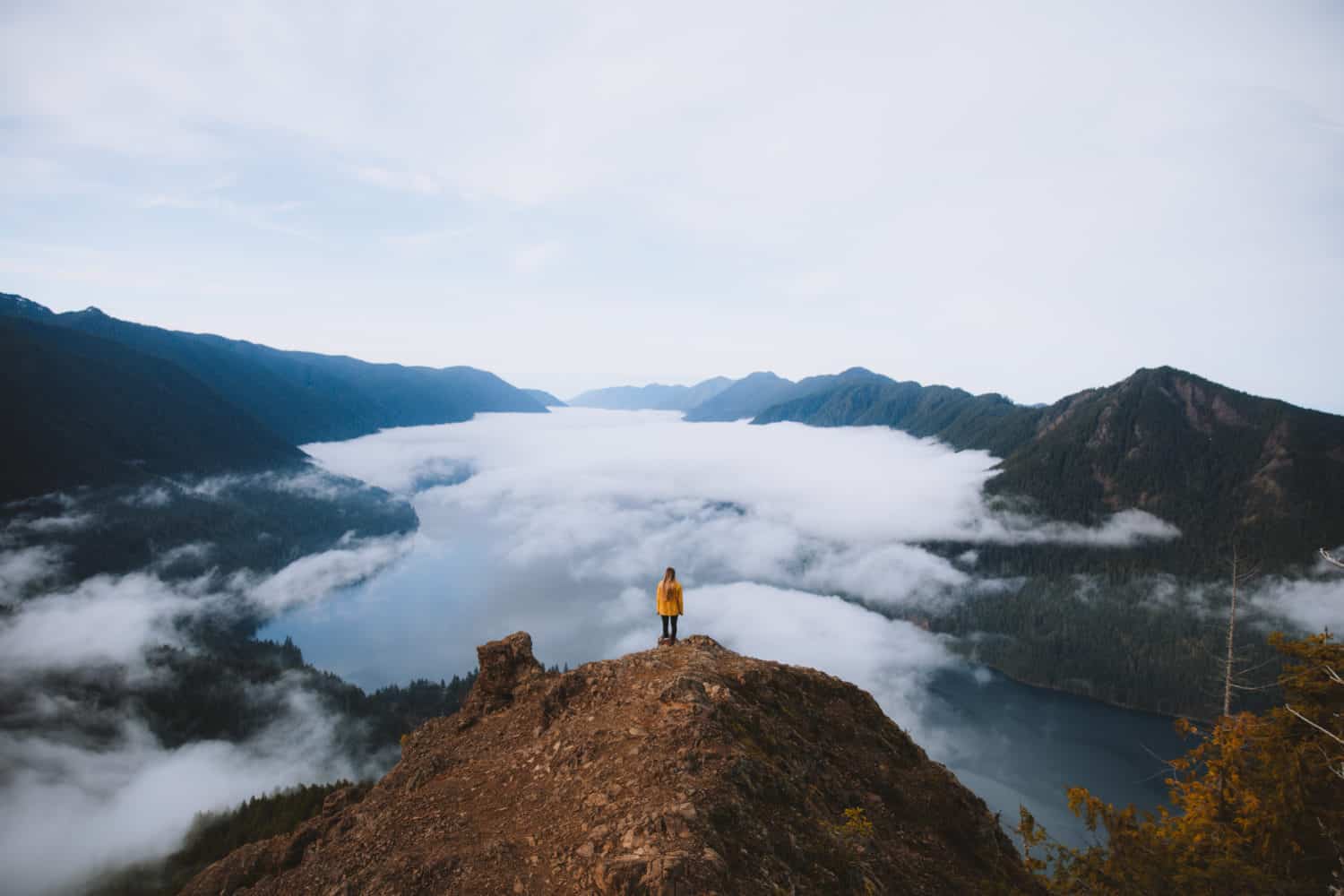
Mount Storm King
- Trail Length: 4.7 miles round trip
- Elevation Gain: 2100 feet
- Difficulty: Moderate-Challenging (top section requires assistance with ropes – can be slippery in bad weather)
- Washington Hiking Features: View of Lake Crescent, Marymere Falls, Iconic Storm King Ranger State
- Trailhead Location: Olympic National Park, Storm King Ranger Station
Mount Storm King is an incredible Olympic National Park winter hiking trail, located near Port Angeles, WA on the Olympic Peninsula. It’s known for its photogenic rock perch above the clouds, with an expansive view of Lake Crescent straight ahead.
Because of the coast’s temperate climate, Mount Storm King trail receives little snow, unless there’s been a heavy storm. You’ll start this Washington winter hike at the famous Mount Storm King Ranger Station, and continue through a lush, green, and foggy forest surrounded by trees.
After lots of switchbacks and tons of elevation gain (AKA get ready to sweat!), you can stop at the sign stating “Trail No Longer Maintained” or you can choose to low-key technical climb the last 5-10 minutes to the very top. You’ll have to use the assistance of a rope to make it all the way to the summit. Go slow and watch your step on this part of the trail – it can be very muddy and slippery.
And as always, never feel like you have to finish a trail if you feel unsafe. If winter conditions make this a scary feat for you, don’t attempt it and come again another time! You can alternately choose to take the Marymere Falls Trail, which is a quick 1.7-mile out-and-back trail from the same trailhead. It’s one of the easier Washington winter hikes with a great reward!
Read More: More Photos From Mount Storm King Trail In The Olympic National Park
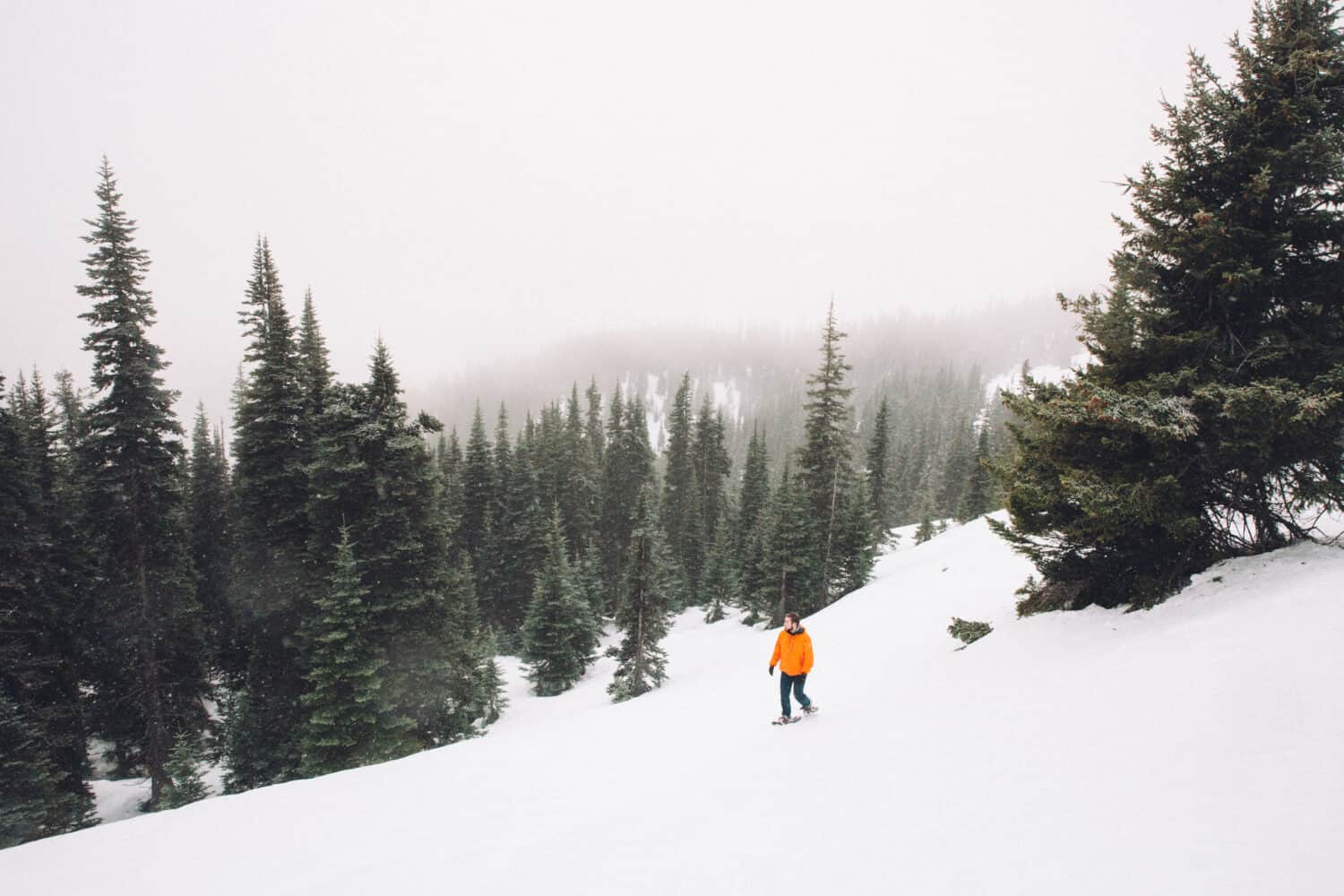
Hurricane Ridge
- Trail Length: 6.0 miles out-and-back
- Elevation Gain: 800 feet
- Difficulty: Moderate
- Washington Winter Hiking Features: Olympic Mountain Views, Water Views to Canada
- Trailhead Location: Olympic Peninsula / Northern Coast
Hurricane Ridge is located on the Olympic Peninsula, just south of the city of Port Angeles. Beginners and experts alike will enjoy this winter hiking trail in Washington! On a bluebird day, you are able to see Mount Olympus in all her glory, and maybe even across the Salish Sea to Victoria, British Columbia!
Hiking “The Ridge” is one of the most popular Washington winter hikes from the Hurricane Ridge Visitors Center. The views alone make it all worth it!
It’s important to note that access to Washington winter hikes on Hurricane Ridge are only available Friday-Sunday in the winter months, from 9:00 am – 4:00 pm. See more about Hurricane Ridge access in the winter here.
Winter Driving Tips: Hurricane Ridge receives a huge amount of snow every winter season! The Olympic National Park does a great job of keeping the roads clear, but make sure to carry snow chains (it’s actually required here) and check road closures in preparation for your winter hike.
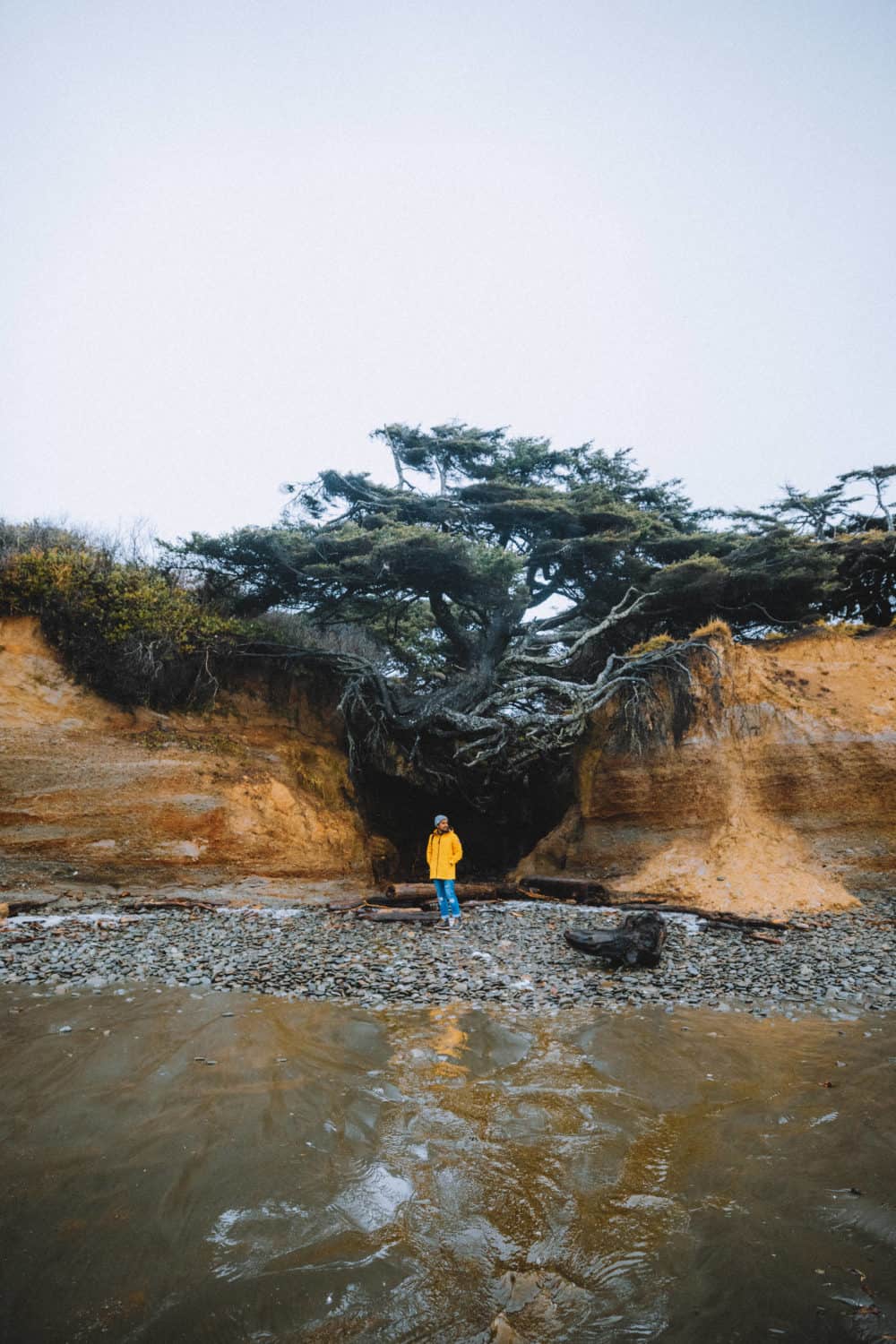
Kalaloch Tree
- Trail Length: >0.2 miles
- Elevation Gain: 10 feet
- Difficulty: Very Easy
- Washington Winter Hiking Features: Tree Root Cave, Pacific Ocean, Washington Beach
- Trailhead Location: Kalaloch Day Use Area, Washington Coast
The Kalaloch Tree Root Cave (pronounced kuh-LAY-lock) is a phenomenon on the Washington Coast in which a tree has rooted itself across an eroding ditch!
You can reach the Kalaloch Tree (often referred to as the Tree Of Life) by parking in the Kalaloch Campground Day Use Area, and following the very short trail and steps down to the ocean.
It’s best to arrive during low tide for the easiest access to the tree. You’ll have to walk a short distance, and if you come during high tide you might get yourself stuck! Save this tide chart for the Kalaloch Area to properly plan your winter hiking trip.
Choose this as your preferred Washington winter hiking trail for its convenience to other winter activities! Explore more things to do in Olympic National Park while on the coast (like Ruby Beach, Rialto Beach, and La Push beaches!) and stay at the Kalaloch Lodge to maximize a weekend trip from Seattle!
Read More: The Complete List Of Top Washington Beaches To Explore This Year
Best Washington Winter Hikes NEAR SEATTLE
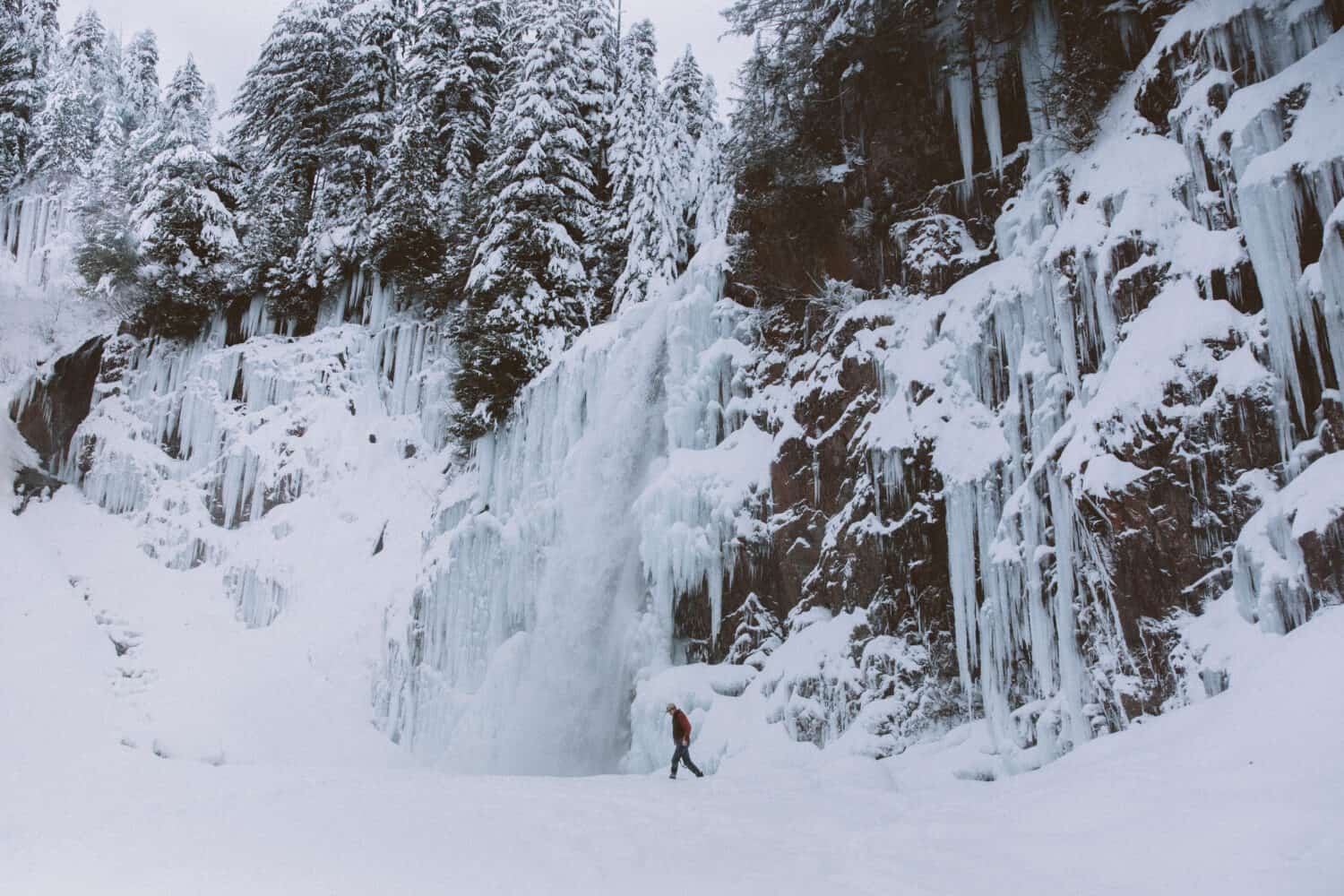
Frozen Franklin Falls
- Trail Length: 2-miles out-and-back (7-miles in heavy snowfall)
- Elevation Gain: 440
- Difficulty: Easy to Moderate
- Washington Hiking Features: Frozen waterfall, Snoqualmie National Forest land
- Trailhead Location: Snoqualmie Pass
The trail to Franklin Falls is open year-round, with a frozen twist in the winter! The 135-foot Franklin Falls is frozen solid in the deep of the season, making this an incredibly scenic winter Washington trail to explore.
Franklin Falls trail is one of the closer and shorter Washington winter hikes, clocking in at 2-miles out-and-back. However, in times of heavy snowfall, the trailhead will be closed, making the total distance 7-miles out-and-back. Most of this extra walking will be on a flat road, so overall it’s an easy trail to take.
Bring microspikes or snowshoes for easier traction. This trail is popular, so there will likely be packed snow/ice along the route.
Read More: 101 Adventurous Things To In The Pacific Northwest (Print This List!)
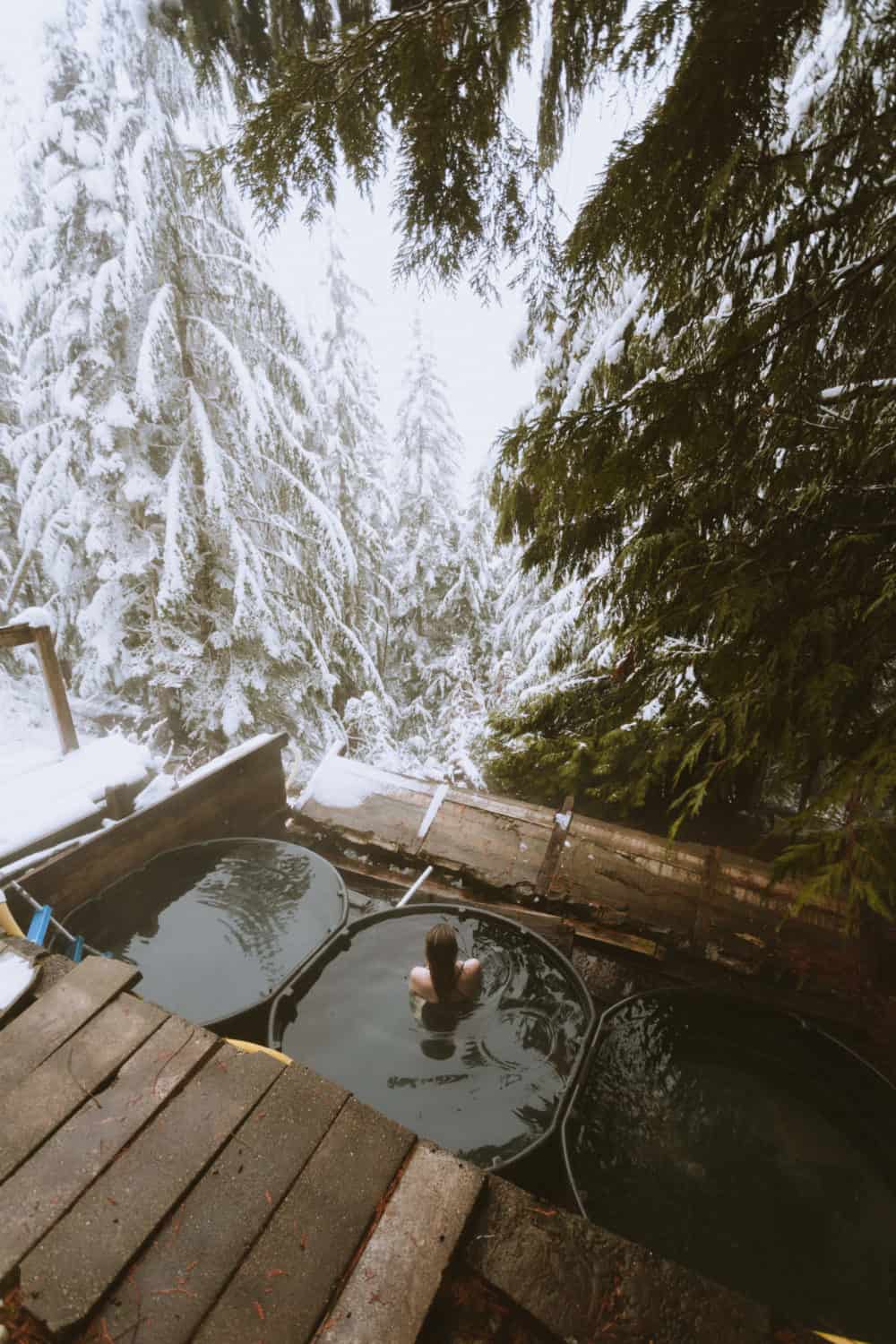
Hike to Scenic Hot Springs, Washington
- Trail Length: 2.2 miles round trip
- Elevation Gain: 1100 feet
- Difficulty: Challenging. Very steep incline for such a short distance.
- Washington Hiking Features: Washington Hot Springs
- Trailhead Location: Stevens Pass Area / Highway 2
Scenic Hot Springs is a privately owned Pacific Northwest hot springs located in the Stevens Pass Area near Skykomish, Washington. Tucked away in the wilderness is the hand-built platform with three giant round tubs, with mineral water constantly flowing into them through a spring in the ground.
Getting here requires a short but very steep hike, which can be a little more challenging in the winter weather. Pack snowshoes, garbage bags to keep your things dry, and plenty of warm layers for this unique Washington winter trail.
Reminder: These Washington hot springs are located on private property, so it’s essential to ask permission before visiting. Read our post about Scenic Hot Springs for more photos and to learn more about the reservation process.
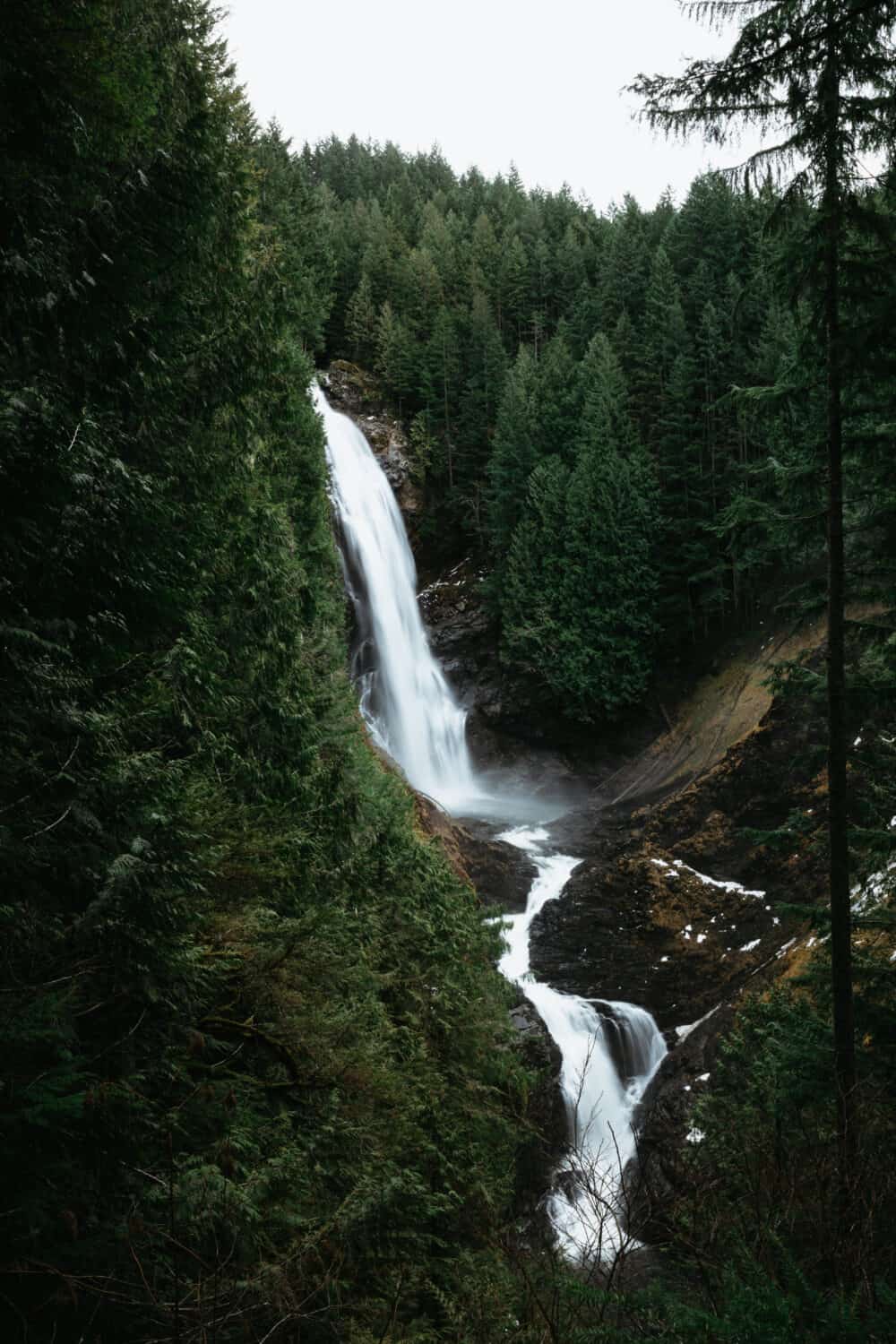
Wallace Falls Trail
- Trail Length: 4.4 miles out-and-back
- Elevation Gain: 1,400 feet
- Difficulty: Moderate
- Washington Winter Hiking Features: Waterfalls, the Cascade mountains with old-growth forest
- Trailhead Location: Stevens Pass West / Highway 2
Wallace Falls is a popular winter hiking trail in Washington for its proximity to Seattle (1-hour drive) and easy car access. The parking lot is large but fills up very quickly on weekends. There are public bathrooms and drinking water available at Wallace Falls Trailhead and dogs are allowed on a leash!
With several views of the falls (especially the Lower and Middle falls), this is an incredible hike if you want all the Pacific Northwest vibes in one afternoon! Bonus points if you visit on a snowy Seattle day trip – the closely packed evergreens surrounding the falls look incredible with a dusting of snow!
The trail doesn’t usually get snow that sticks unless there’s been a really big storm so expect the hike to be muddy and wet.
Reminder: Make sure to show your Washington Discover Pass ($30 annually). Read about what you can access with this Pacific Northwest forest pass here!
Read More: What To Expect on Wallace Falls Trail in Washington State
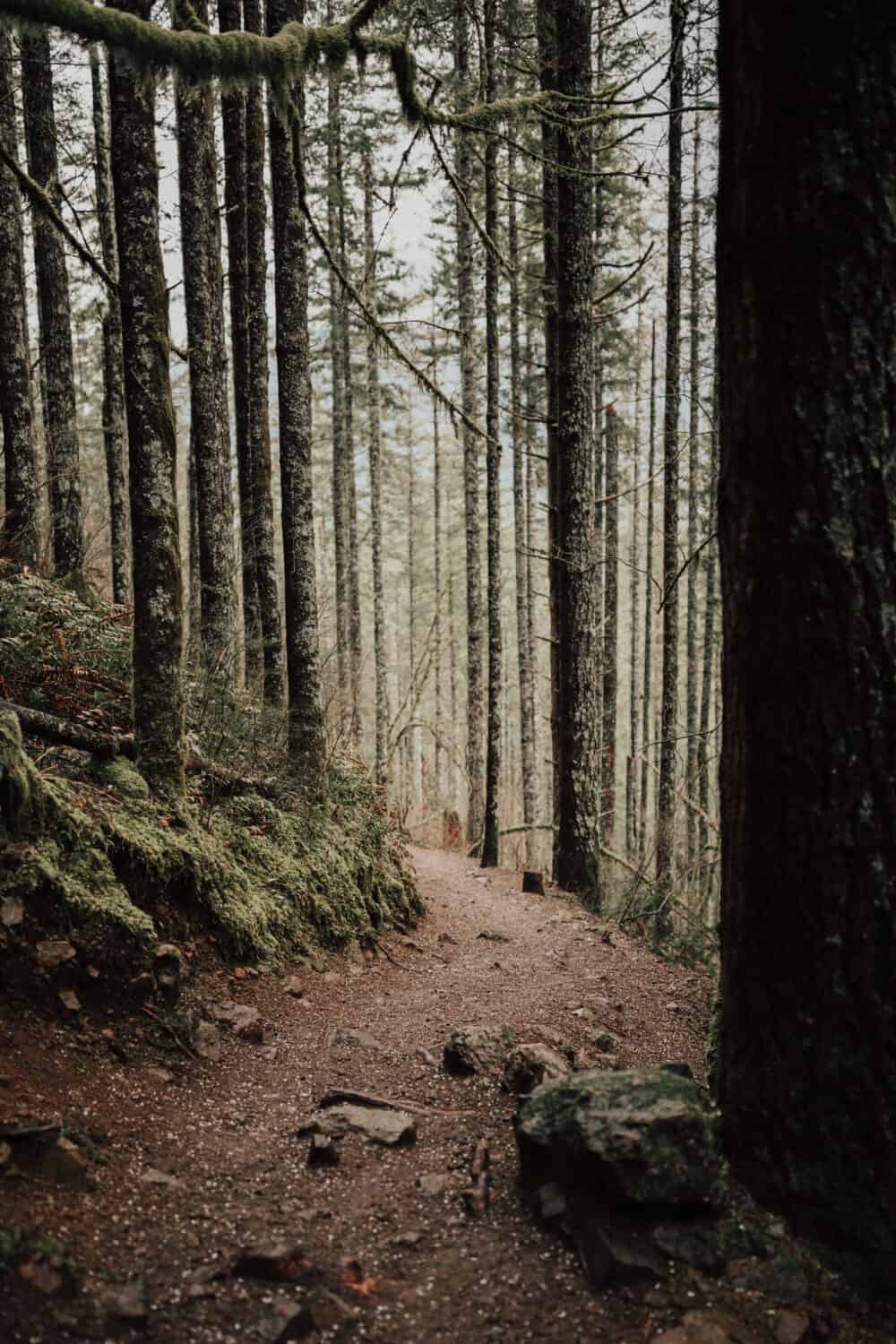

Rattlesnake Ledge
- Trail Length: 4 miles out-and-back
- Elevation Gain: 1160 feet
- Difficulty: Moderate
- Washington Winter Hiking Features: Views of Rattlesnake Lake, dense winter woods
- Trailhead Location: Snoqualmie Region / North Bend Area
Rattlesnake Ledge is one of the most popular hiking trails near Seattle, Washington. It’s popular year-round for its easy access, dog-friendly trail, and a distance/elevation that’s great for beginning hikers.
If you plan to visit Rattlesnake Ledge trail in the winter, come equipped with microspikes in your backpack. The majority of the path is covered under a canopy of trees, but the top brings you out to an exposed rock face with views of the surrounding Snoqualmie area.
Under snowy and icy conditions, these rocks can be really slippery, so we advise you to stay VERY far away from the ledges and utilize those microspikes for extra grip!
Read More: 10 Essentials For Hiking In The Pacific Northwest

Heather Lake
- Trail Length: 4.5 miles out-and-back
- Elevation Gain: 1100 feet
- Difficulty: Moderate
- Washington Winter Hiking Features: Alpine Lake
- Trailhead Location: Mountain Loop Highway Area
Heather Lake Trail is located in the Mountain Loop Highway, about an hour’s drive away from Seattle. Just like many other Seattle hikes along this highway, prepare for a bumpy, pothole-ridden drive to the trailhead. (Additionally, keep driving down the same NF-4220 Road to reach the Mt Pilchuck Lookout hike in the summer!)
Due to its lower elevation than other nearby hikes (the highest point is 2,340 feet), you won’t find much snow on the beginning of the Heather Lake trail unless there has recently been a heavy storm.
However, all of that changes once you reach the top, with ice and packed snow expected on the trail. Bring a pair of crampons/microspikes to help you keep your grip.
On our last trip to Heather Lake, we packed a thermos and had a hot chocolate break at the top, but you can also make your way down the trail and have a cozy lunch in Granite Falls, just 20 minutes from the trailhead! It’s one of the easiest Washington winter hikes to reach from Seattle!
Big Four Ice Caves
- Trail Length: 2.2-mile out-and-back
- Elevation Gain: 220 feet
- Difficulty: Easy
- Washington Winter Hiking Features: Ice Caves
- Trailhead Location: North Cascades / Mountain Loop Highway
*THIS TRAIL IS CURRENTLY CLOSED* The Stillaguamish River footbridge is currently broken and scheduled for repair. We’re adding it to our Washington winter hikes list regardless, to update and share with you when it re-opens once again!
The Big Four Ice Caves is an easy, family-friendly Washington winter hiking trail to see some amazing ice caves at the foot of Big Four Mountain. The trail is a wide, gravel path that first leads you through the trees, past some marshes, and ultimately brings you to the foot of the caves.
We must share with you that you should never enter the ice caves. These unstable structures can collapse at any time and unfortunately have killed visitors in the past. Stay at the viewing area, and enjoy the scene from the safety of the platform!
Car Safety Tip: Unfortunately this place is notorious for car theft. If you plan to take this winter hiking trail in Washington, don’t leave anything valuable in your car!


Lake Wenatchee State Park
- Trail Length: >0.5 miles
- Elevation Gain: >50 feet
- Difficulty: Very Easy
- Winter Hiking In Washington Features: Lake Wenatchee, Island on the Lake
- Trailhead Location: East Stevens Pass, Lake Wenatchee State Park
A winter trip to Lake Wenatchee is essential for incredible views of this icy, Narnia-like island in the middle of the lake!
Park at the Lake Wenatchee State Park Beach and take the short trails around the shore to find the prettiest perspectives of Emerald Island. You won’t find these trails to be strenuous, but prepare to climb over rocks and downed trees, so pack a backpack to keep your hands free.
If you’d like to stay and experience the lake another way, check out these Lake Wenatchee snowshoeing trails, which are easy afternoon trips from 1.5-mile treks all the way up to 3.8-mile excursions. Alternatively, if cross-country skiing is more your jam, check out the Lake Wenatchee XC trail reports here!
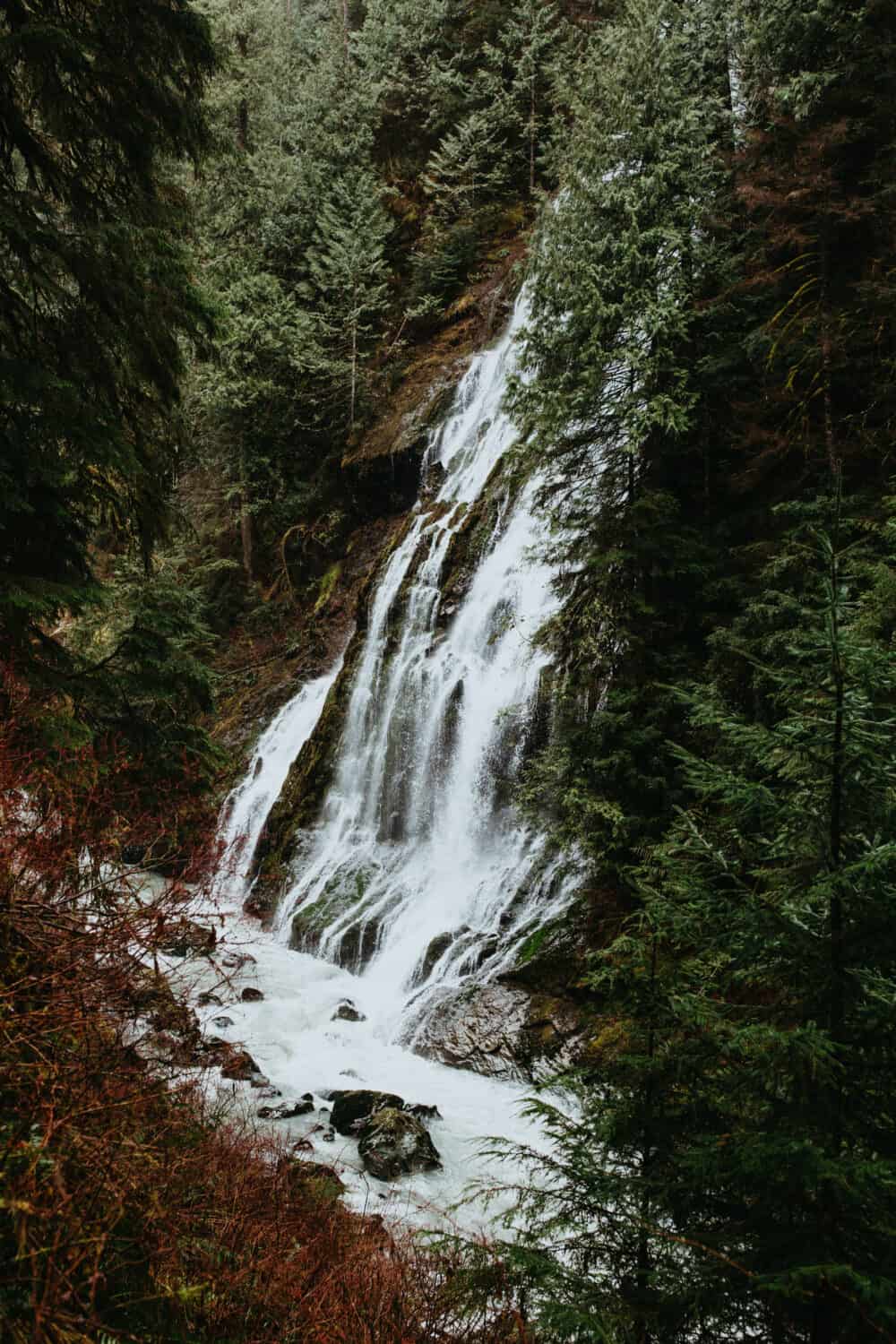
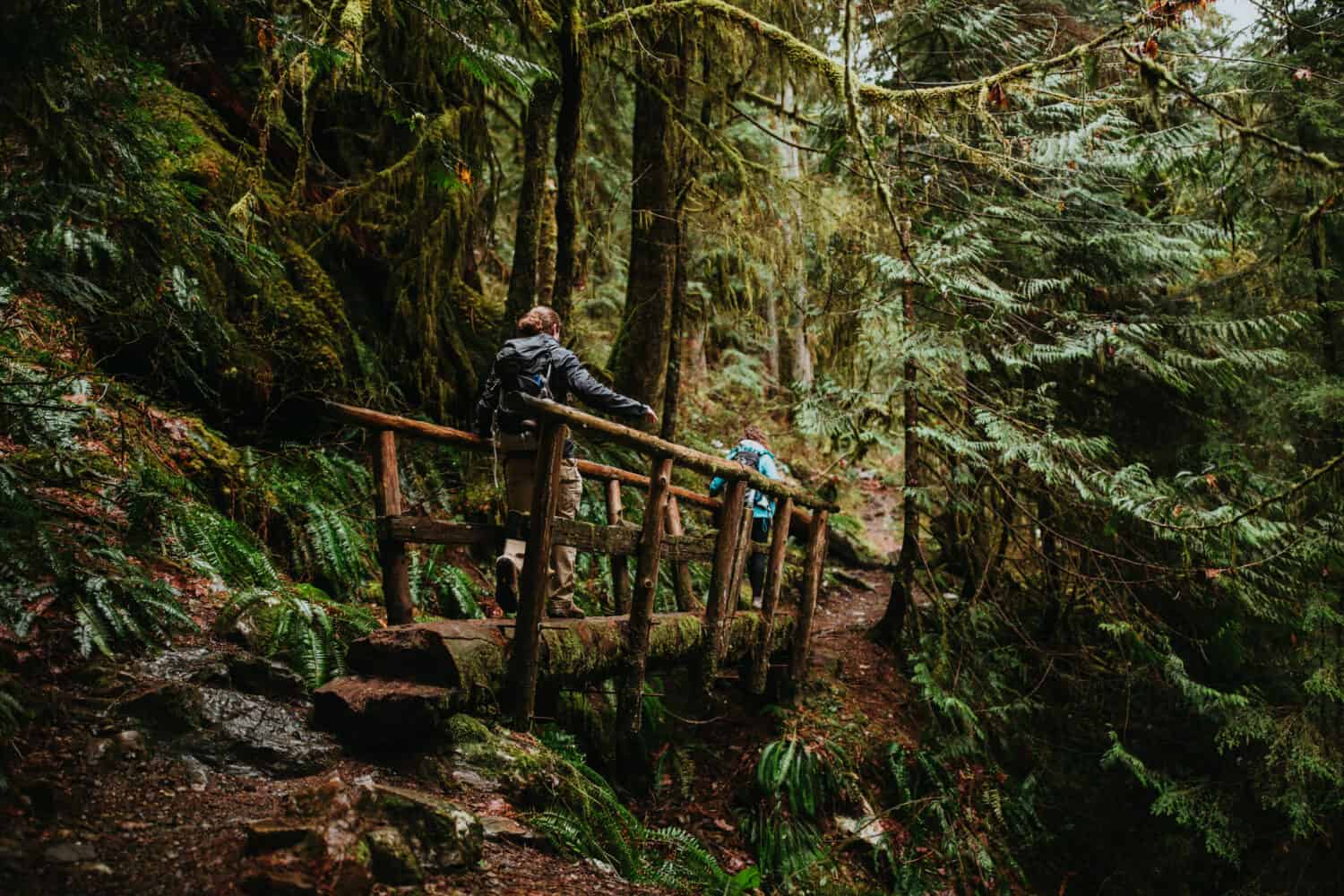
Boulder River Falls
- Trail Length: 2.4 miles round trip (8.8 for the entire length – see more below)
- Elevation Gain: 1,600 feet
- Difficulty: Easy (but with a high chance of being icy)
- Washington Winter Hiking Features: Unnamed waterfall, walking in an old-growth forest alongside the river
- Trailhead Location: Mountain Loop Highway, 48.2509, -121.8172
Boulder River Trail is one of the easier trails in the Mountain Loop Highway. Because of its very gradual and well-maintained trail in combination with the water features, this is a popular day hike for families. The Boulder River Wilderness provides the typical Washington hiking experience: fern-lined trails and a wet canopy of moss-covered trees.
The entire trail is 8.8 miles and it seems daunting, but you can go as far as you’d like before turning around. The unnamed waterfall is around mile 1.2, which is a common turnaround point for most hikers. The farther you go along the trail, the rougher it becomes with broken bridges and possible tree debris on the trail. Prepare to get muddy!
Winter Driving Tip: To reach the trailhead, you’ll have to take a 10-minute drive on a gravel road. The combination of potholes and winter conditions have the ability to cause problems with traction and progress, so make sure to bring a shovel, some rock salt, and maybe even some tire chains! If there are potholes present, go slow and take your time!
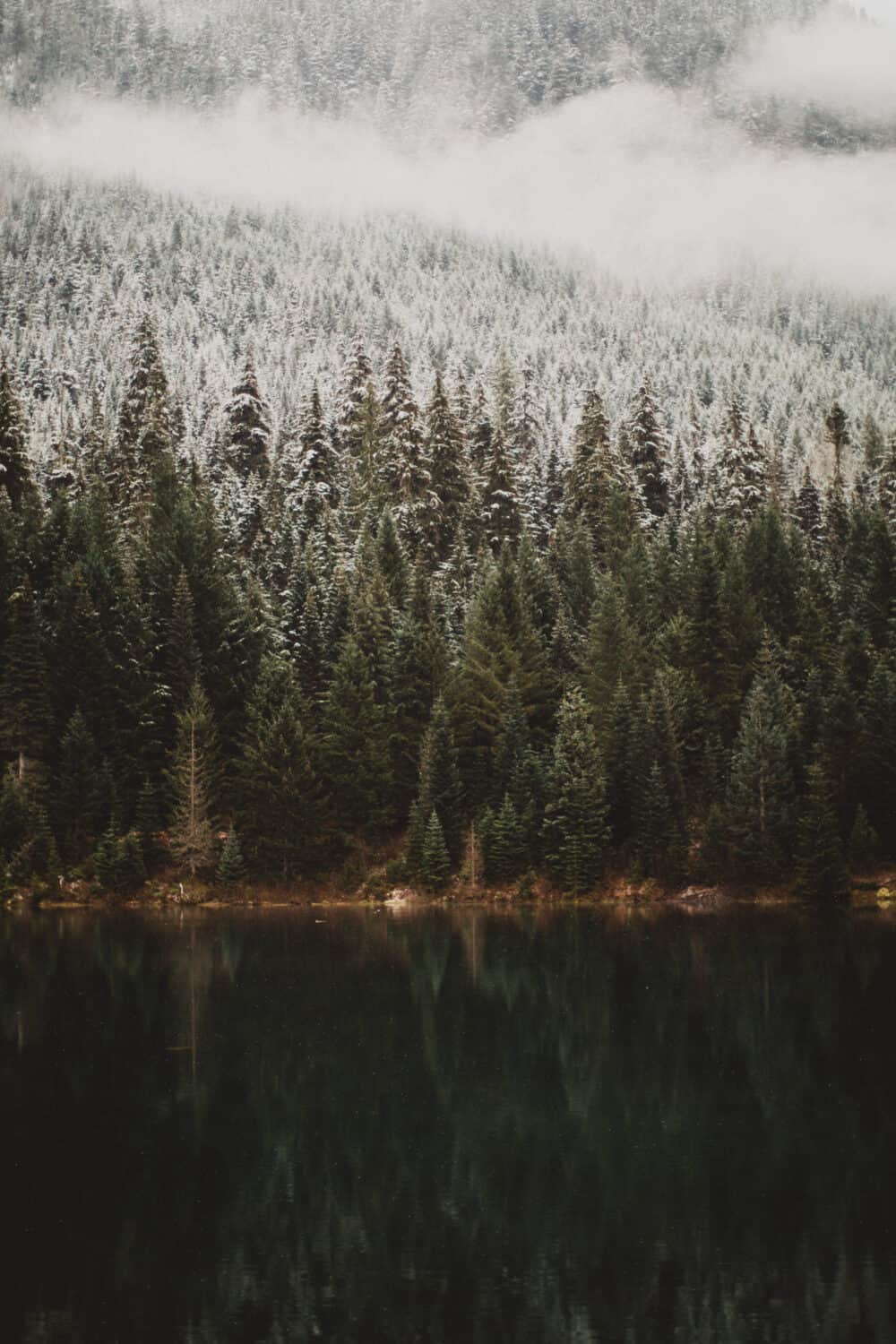
Gold Creek Pond
- Trail Length: 2.3 miles out-and-back (a popsicle loop)
- Elevation Gain: 100 feet
- Difficulty: Easy
- Washington Winter Hiking Features: Snowshoeing, Lake Views
- Trailhead Location: Snoqualmie Pass
Gold Creek Pond Trail is an easy, 1.0-mile loop around Gold Creek Pond in the Snoqualmie Pass Area of the Cascade Mountains. This is one of the best Washington winter hikes for snowshoeing beginners for its flat trail and easy walk!
The regular Gold Creek Pond Trail distance is 1 mile, but in the wintertime the Forest Service road is unplowed. This means you’ll have to start your trail about a half-mile back from the regular starting point.
Because it sits at 3000 feet elevation, it’s almost guaranteed to have snow all winter long. Come take this Washington winter trail for its serene views, easy intro to snowshoes, and beautiful snow-covered evergreens!
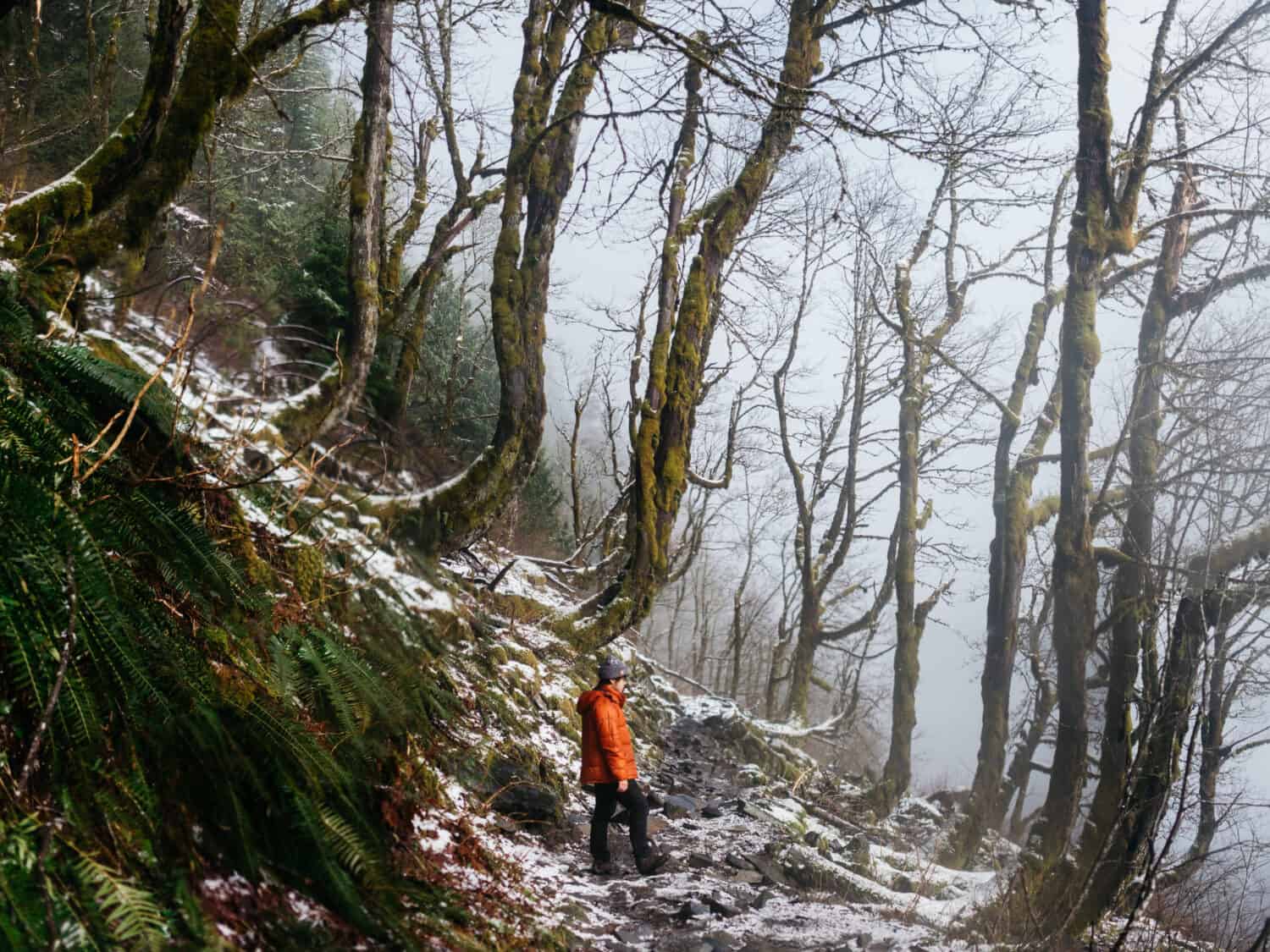
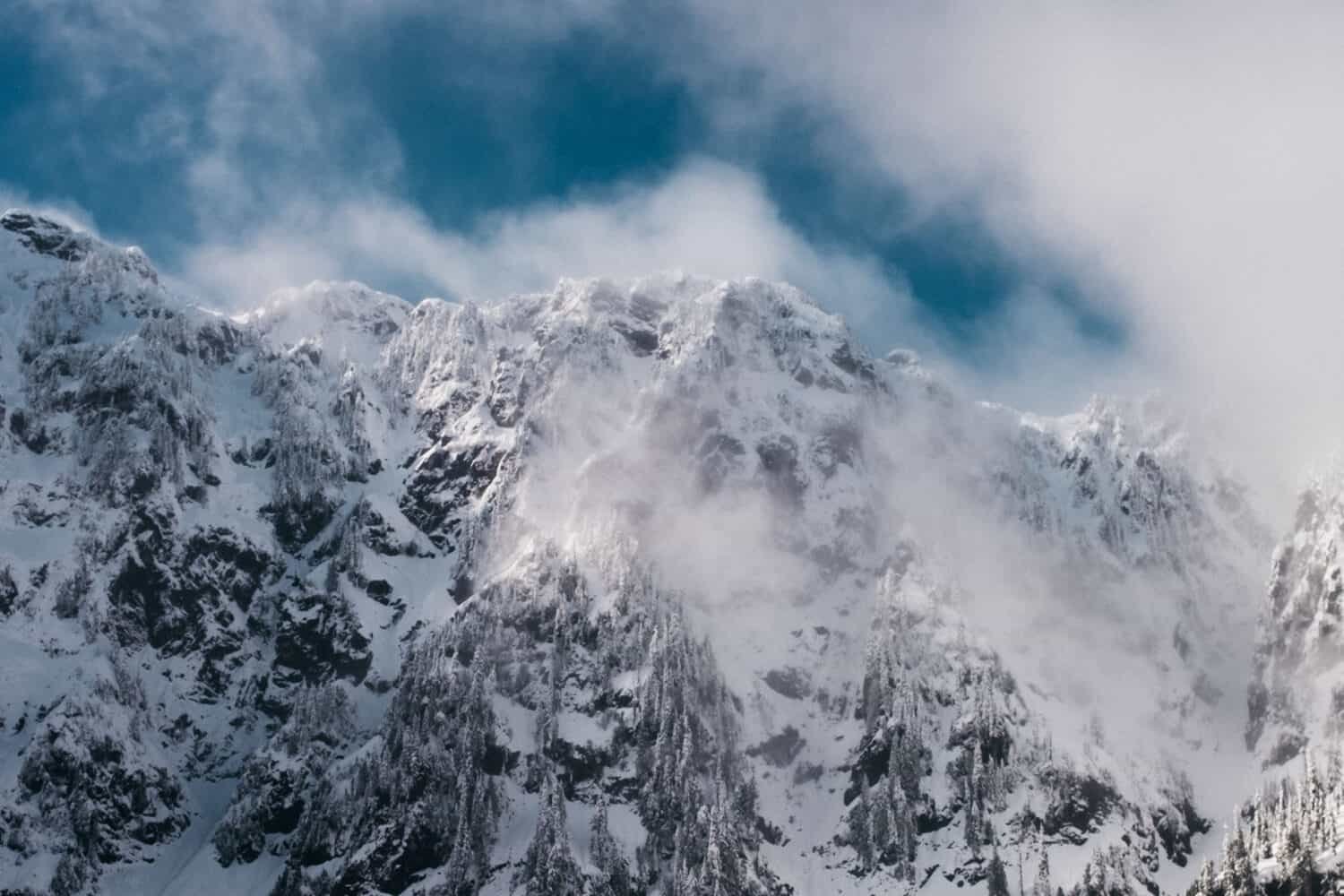
Lake Twentytwo (Lake 22)
- Trail Length: 5.4 miles out-and-back
- Elevation Gain: 1,400 feet
- Difficulty: Moderate
- Washington Winter Hiking Features: Alpine Lake, Mount Pilchuck Views
- Trailhead Location: Mountain Loop Highway
- Pass Required: Northwest Forest Pass
Important Note: This area is prone to avalanches. If you choose to go, know your ability to assess the situation, and how to properly act if one occurs. If you don’t feel prepared, don’t fret. There are many other Seattle winter hikes to choose from!
Just on the other side of Mt Pilchuck is Lake Twentytwo, getting its namesake from a theory which states that local railroad maps just named the lakes numerically according to the location they were placed on the map. Pretty interesting that the other lake names were changed but this one just stuck!
This is a unique Washington winter trail because it takes you through switchbacks under an old-growth forest, across a bridge with a rushing falls underneath, and a boulder field open to the Washington winter skies.
The top will reward you with views of Lake 22, and towering views of the north face of Mt Pilchuck. If you come in late winter or early spring, you may even get to witness an avalanche from a distance or a waterfall from runoff.
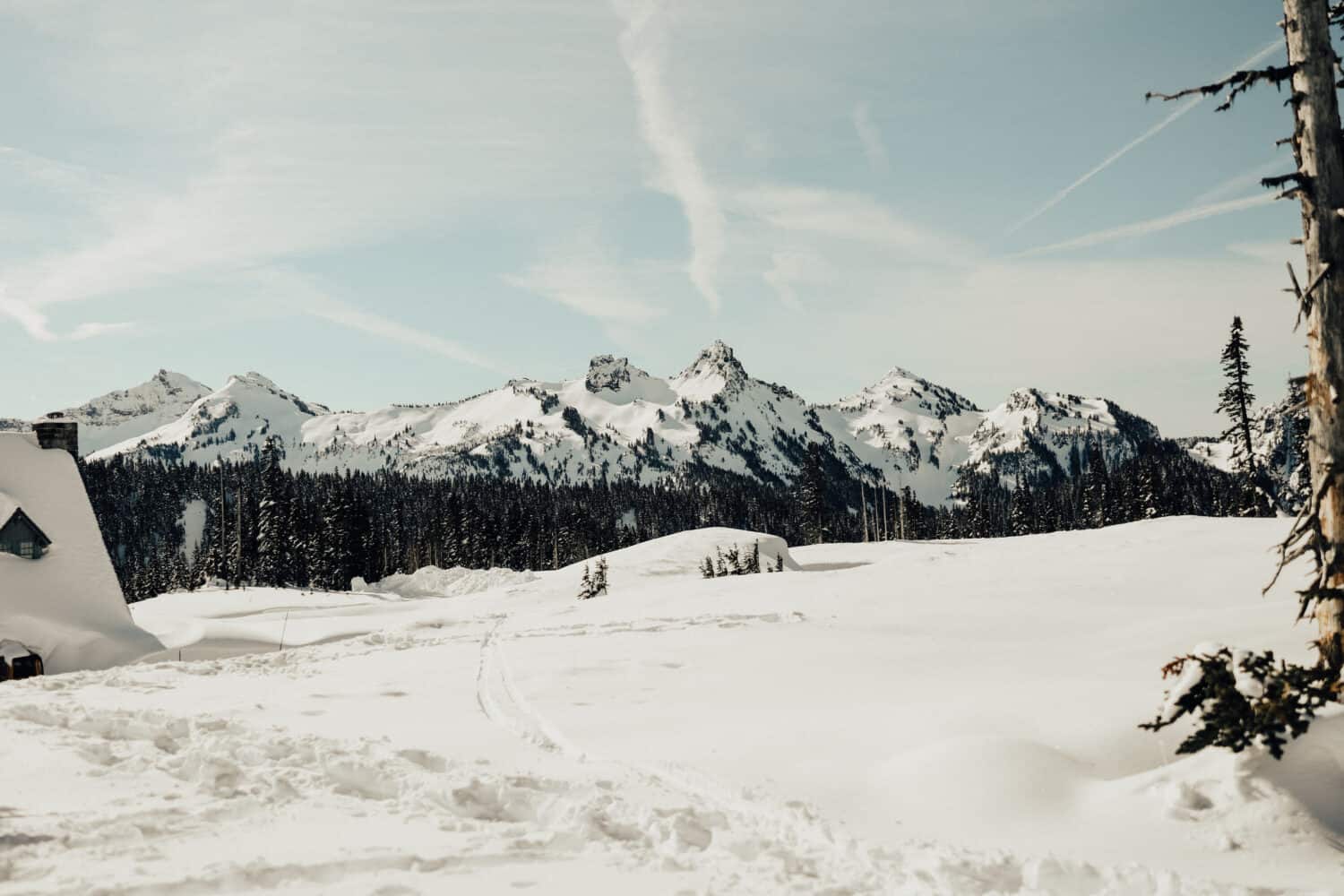
Mt. Rainier Paradise Area
- Trail Length: 1.8 miles
- Elevation Gain: 200 feet
- Difficulty: Easy-Moderate
- Washington Winter Hiking Features: Mount Rainier Views
- Trailhead Location: Paradise Area of Mt Rainier National Park
Mount Rainier is known for its amazing summer backpacking trails and seasonal wildflowers, but did you know you can also enjoy this area in the winter?
One of the most popular Washington winter hikes to take here is Nisqually Vista Loop which is an easy trail that winds you through trees with plenty of views of Mt Rainier in the distance! The Paradise Area of Mt Rainier opens every day at 9:00 am, but check road conditions on the day of your trip to determine if it’s safe to drive to the top.
Don’t have your own gear and don’t know where to go? Ranger-Led Snowshoeing Excursions run from late December through March and are a great way to introduce you to winter hikes on Mount Rainier. Snowshoes are provided and a $5 donation is suggested for participating!
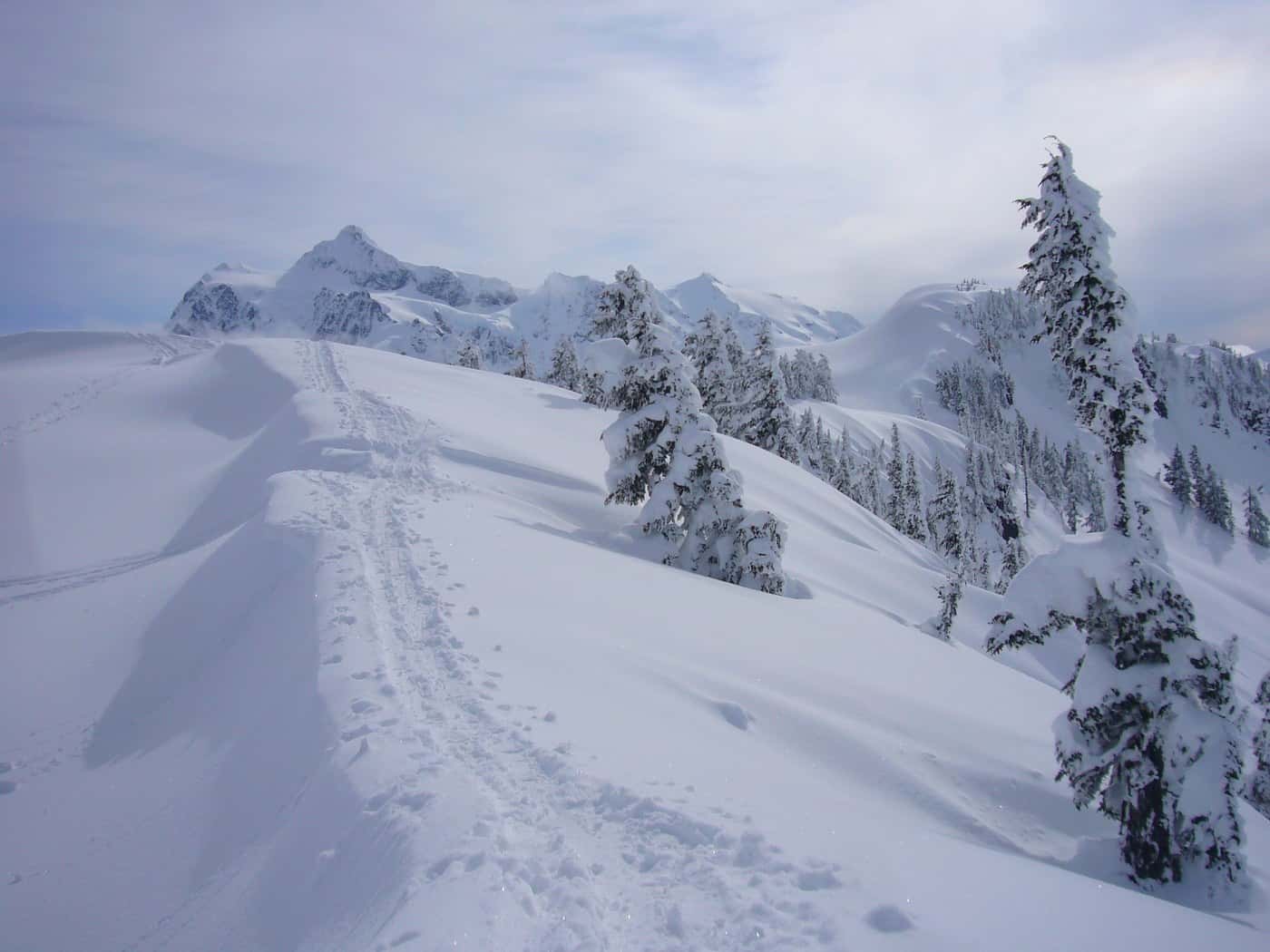
Snowshoeing To Artist Point, Washington
- Trail Length: 4 miles round trip
- Elevation Gain: 1000 feet
- Difficulty: Washington Hiking Features: Mt Shuksan Views,
- Trailhead Location: Mt Baker Ski Area
Located in the Mt Baker ski area, Artist Point is a gorgeous winter hike in Washington that should not be missed! This incredibly scenic, 4-mile round trip hike will wow you with its gorgeous views of Mt Shuksan, Goat Mountain, Mt Larrabee, and American Border Peak.
This area sees deep snow every winter, so make sure to pack snowshoes, gaiters, and plenty of waterproof layers for your winter hike.
Before you go, check avalanche and road conditions to see if these are safety risks for you and your group. This hike is in avalanche territory, and the road has historically closed in cases of heavy snowfall.
What To Pack For Winter Hikes In Washington
When venturing out on Washington winter hiking trails, it’s important to pack the right gear for your trip!
Read this list below to prepare for your own successful hike, which elaborates and expands on the 10 winter hiking essentials above.
Also Read: The Ultimate Guide To Layering Clothes In Winter Season
Snowshoes
For Winter hikes in Washington with deep, powdery snow, snowshoes are an essential part of a fun hike experience! Berty and I both own a pair of Tubbs Snowshoes, which we have loved so far!
Hiking Poles
Hiking poles are a great addition to snowshoes. They help to help you keep your balance on steeper terrain and uneven surfaces on Washington winter hikes.
Winter Hiking Boots
The best hiking boots for winter hiking trails in Washington are pairs that have both insulation AND waterproofing. Because you’ll get a heavy dose of both rain and snow in the Pacific Northwest, it’s important to keep your feet warm and dry to be able to spend the most time outside!
Snowpants
For Washington winter hikes like Hurricane Ridge, Artist Point, or Mount Rainier, it’s important to wear a pant that’s waterproof. This will keep you dry in sections of deep snow!
Down Jacket / Waterproof Outer Layer
When hiking in Washington in the winter season, we’ve learned that lightweight down jackets work the best for us.
We often choose trails that work up a sweat, and we overheat quickly in large parkas and giant puffy coats. We prefer a light but tough option like The North Face Thermoball Eco Hoodie, paired with a thin waterproof outer shell for rainy days.
Hat
Wearing a hat will help preserve your body heat when outside for long periods of time. Make sure you have one that covers your ears, and the sky’s the limit for the style you want to wear!
Mittens/Gloves
When on Washington winter hikes, we prefer lightweight, thin gloves to keep our hands warm with the freedom to use our cameras. We reserve mittens for times when we’re standing in one place for a while, like when taking long-exposure photos with a tripod.
Sunscreen
It may not seem essential, but the sun can reflect off the snow in the wintertime and burn your skin the same as the sun! Make sure to pack sunscreen for longer Washington winter hikes on exposed ridges and places with few trees.
Sunglasses
Similar to sunscreen, sunglasses are an essential way to help you navigate those Washington winter trails on bright bluebird days.
Avalanche Beacon
This tool may not be for everyone, but if your heart is set on taking a Washington backcountry winter hiking adventure, we highly recommend you purchase an avalanche kit. An avalanche kit includes an avalanche beacon, an avalanche probe, and a shovel at the very least.
This will increase your chances of survival in the terrible case of an avalanche, and allow rescuers to find you (or your party) quickly.
Map of Washington Winter Hiking Trails
Click on the google map to save all these Washington winter hikes to your own phone!
What are your favorite Washington winter hikes in the Pacific Northwest? Share them in the comments below!
MORE Pacific Northwest Winter Activities
20+ Things To Do In Banff In Winter
20 Things To Do In The Columbia River Gorge
Hike To Falls Creek Falls Trail In The Columbia River Gorge
The Ultimate Olympic National Park Road Trip
10 Washington Beaches You Have To Explore This Winter
101 Adventurous Things To Do In The Pacific Northwest
Visit The Boiling River Hot Springs In The Winter
